






























































































































PUBLISHING
Publisher / General Manager
Jules Kay
Associate Publisher / Head of Brand & Marketing
Richard Allan Aquino
Publishing Assistant / Marketing Relations Manager
Tanattha Saengmorakot
EDITORIAL
Editor
Duncan Forgan
Deputy Editor
Al Gerard de la Cruz
Digital Editor
Gynen Kyra Toriano
Editorial Contributors
Liam Aran Barnes, Bill Charles, Steve Finch, George Styllis, Jonathan Evans
CREATIVE & MARKETING
Head of Creative
Ausanee Dejtanasoontorn (Jane)
Senior Graphic Designer
Poramin Leelasatjarana (Min)
Digital Marketing Executive
Anawat Intagosee (Fair)
Senior Manager, Media & Marketing Services
Nate Dacua
Senior Executive, Media & Marketing Services
Piyachanok Raungpaka
Senior Product Lifecycle & Brand Manager
Marco Bagna-Dulyachinda
REGIONAL SALES & DISTRIBUTION
Director of Sales
Udomluk Suwan
Head of Regional Sales
Orathai Chirapornchai
Australia
Watcharaphon Chaisuk
Cambodia
Phumet Puttasimma
China (Mainland, Hong Kong, Macau)
Kai Lok Kwok
Yiming Li
India & Sri Lanka
Monika Singh
Indonesia
Wulan Putri
Malaysia
June Fong
Jess Lee
Philippines
Marylourd Pique
Maria Elena Sta. Maria
Singapore
Alicia Loh
Thailand
Kritchaorn Rattanapan
Vietnam
Nguyen Tran Minh Quan
Sponsorships
Priyamani Srimokla
Distribution Manager
Rattanaphorn Pongprasert
General Enquiries
awards@propertyguru.com
Advertising Enquiries petch@propertyguru.com
Distribution Enquiries ying@propertyguru.com PropertyGuru









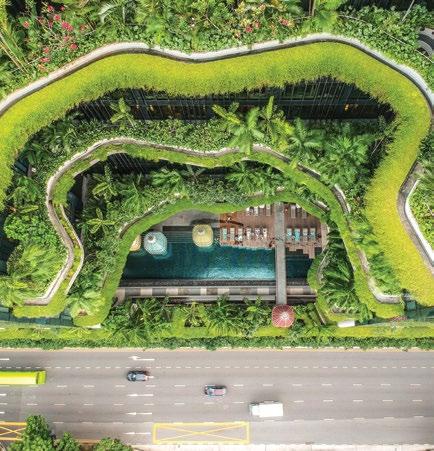

Neighbourhood Watch: Bang Na
This Bangkok enclave flaunts proximity to an international airport, top schools, and an array of real estate investment options

Destination: Vietnam
Vietnam’s property scene has experienced its most traumatic period with corruption scandals sending the market into freefall
Special Feature: Sprout to the top
Developers are being incentivised to push a green agenda into daring new realms
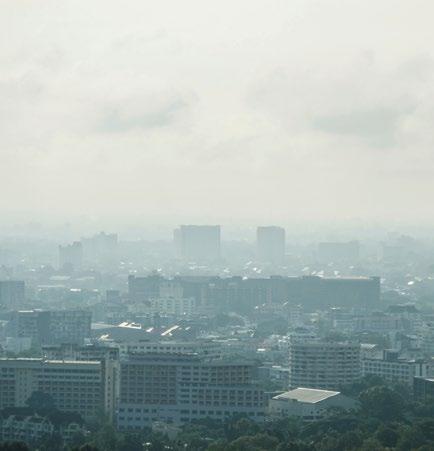
Dispatch: Lost in the haze
Thailand’s persistent problems with polluted air are prompting calls for tougher government action
Destination: Australia
A housing crisis deepens in Australia where foreigners and locals are vying for lucrative property investments as well as roofs over their heads

Dispatch: On the right road
The global EV boom is fuelling industrial real estate sectors around Southeast Asia












It took some time to gain momentum, but it’s clear to see that the green real estate revolution is well and truly in motion. And a good thing too. Here in Asia, we live, work and stay in a region that — experts say — is one of the most vulnerable in terms of climate risks. Therefore, green estate is important for several reasons.
It helps reduce greenhouse gas emissions and mitigate the impact of climate change. Buildings are responsible for significant global greenhouse gas emissions, and sustainable real estate can help reduce this impact. In addition to that, it can help reduce energy consumption and costs, and improve indoor air quality, creating a healthier and more comfortable environment.
Given all this, it is a delight to be able to present an array of green champions in this, our sustainability issue. We’ve stayed close to home in our interview this issue, quizzing PropertyGuru Group’s head of sustainability Cecile Corda on new programs to help property seekers make more considered choices. Elsewhere, on an eco-friendly tack, we run the rule over LIMA Estate in The Philippines and round up some of the region’s best sustainable projects.
You’ll also find market updates from Australia and Vietnam, as well as insight from Sasivimol Sinthawanarong, the founder of awardwinning practice JARKEN.
Enjoy!

Duncan Forgan Property Report duncan@propertyguru.com


Filipino developer SMDC lights the way forward to a new, inviting, convenient kind of lifestyle in one of the most desirable neighbourhoods of the Philippine capital

Working professionals in the capital of the Philippines will most likely find themselves coming home to Mandaluyong.
A city at the intersection of livelihood, lifestyle, and leisure, Mandaluyong is one of Metro Manila’s busiest areas—to live in Mandaluyong is to live strategically close to one’s workplace. Investing in this neighbourhood is also tantamount to opening a world
of opportunities for tenants who hope to grow their professional life in Metro Manila.
Mandaluyong is situated just next to Makati, the financial heart of the metropolis, and covers part of Ortigas, home to the headquarters of organisations such as the Asian Development Bank (ADB) and San Miguel Corp., plus large shopping malls and hotels. The area is also
becoming known for a new generation of sustainably designed office developments.
More importantly for many, Mandaluyong encompasses prominent transport routes such as EDSA, Shaw Boulevard, and Pioneer Street, as well as the MRT.
Joining SMDC’s growing family of wellconnected residential developments, Light 2 Residences has risen to become one of Mandaluyong’s best places in which to live. Launched off the success of Light Residences, Light 2 Residences was hailed the Best Mid-End Condominium Development in Metro Manila at the PropertyGuru Philippines Property Awards in 2023.
Light 2 Residences offers superior connectivity, among many other features. These homes are located along the Mandaluyong stretch of EDSA, the most vital thoroughfare in Metro Manila. From this location, the property empowers residents to live where they shop and play within a short distance of their offices.
A bridge connects the towers of Light 2 Residences to Light Residences, which has a direct connection to an all-important mass transit hub in Metro Manila, the MRT 3 Boni-Station. Such a strategic location would be advantageous to residents who commute to work daily.
Light 2 Residences also has the advantage of having its own shopping hub: Light 2 Mall. Designed by Miamibased design firm Arquitectonica, Light 2 Mall encapsulates a wide selection of shops, F&B establishments, and leisure

options so that homeowners need not venture far.
In addition, Light 2 Residences is only a few minutes’ drive from major central business districts aside from Ortigas and Makati, such as BGC and the Mall of Asia Complex.
Further adding to Light 2 Residences’ connectivity is its proximity to massive retail destinations such as SM Megamall and The Podium, among the country’s largest and best shopping malls.
Light 2 Residences suits students, too, thanks to its proximity to institutions such as Rizal Technological University, St. Pedro Poveda College, University of Asia and the Pacific, Lourdes School of Mandaluyong, Ateneo School of Medicine and Public Health, Jose Rizal University, and Don Bosco Technical College.
Residents are never far away from their doctors. They can have their medical needs attended to at nearby health institutions such as Makati Medical Center, VRP Medical Centre, Unciano General Hospital, Mandaluyong Medical Centre, and The Medical City. Light 2 Residences is also home to a well-furnished gym and yoga area, as well as fitness and training centres in the surrounding neighbourhood.
In addition to Light 2 Mall, Light 2 Residences includes an exclusive, nearly one-hectare urban garden. Designed by Hong Kong landscape architecture firm ALN, the garden is a spacious communal area where residents can easily seek respite from the bustle of the metropolis.
The property also offers party lounges and entertainment facilities, including game and KTV rooms, where residents can celebrate in the company of guests. Friends and families can also enjoy some quality time at the adult, children, and shallow pools.
Overseen by SMDC’s very own expert property managers, Light 2 Residences maintains the highest standards of upkeep, ensuring a profitable
investment engine that is built to last. Large households and those with sophisticated lifestyle demands can easily combine units to satisfy their spatial preferences.
Comprehensive CCTV coverage always keeps the property safe and secure while receptionists, doorpersons, and concierge attend to residents’ needs.
Despite being located in the heart of Metro Manila, the homes of Light 2 Residences are surprisingly light on the pocket but heavy on privileges for property seekers. Given such geographic advantage and lifestyle value, these spacious, thoughtfully planned units can offer great returns for years to come, if not just an outstanding address to call home.

As global warming escalates, energy-saving and sustainable devices rise to the top of consumers’ minds

The Bamboozle compost bin transforms scraps into fertilizer without the wait for organic decomposition. Its sleek design includes a vented lid with a charcoal filter to reduce odours. Ultimately biodegradable—it’s made from bamboo fiber— the bin comes in stylish colours, blending seamlessly into modern kitchen settings.
From USD40, bamboozlehome.com


Unplugging is still the most sustainable choice, but the TP-Link Kasa Smart Wi-Fi Plug Slim comes close. Compatible with smart platforms like Alexa and Google Home, this voice-controllable plug provides real-time energy monitoring via your phone and automates device power cycles.
From USD35.99, tp-link.com
Remove the need for singleuse bottles through the SodaStream E-Terra, which turns water into fizzy drinks at the touch of a button. This sparkling water maker comes with a reusable bottle that can be used for years and three presets for your preferred carbonation levels.
From 139.99, sodastream.com
The Jackery Explorer 2000 Plus can catch a solar charge in just two hours. It features advanced lithium technology with capacities starting at 2,042.8Wh, powering heavy appliances like airconditioners. It can even support five additional battery packs simultaneously, expanding capacity to an impressive 12 kWh.
From USD3,299, jackery.com


Ecobee’s Energy Star-approved smart thermostat easily adapts to schedules for optimal comfort and energy savings. Featuring voice commands, remote sensors, and an integrated Alexa speaker, it offers precise indoor climate control. The thermostat also learns habits, adjusts temperatures based on occupancy, and monitors air quality.
From USD149.99, ecobee.com
Eco-friendly, fair-trade furniture holds many positive outcomes for users and the planet

With over 100 modular configurations, the Eva Everyday Sofa is a seat for all occasions. The sectional has sustainably sourced, strong hardwood and plywood for its frame, encased in 100% polyester with multiple layers of foams.
AUD4,260, eva.com.au


The backstory behind the handwoven Malawi Cane Chair is as interesting as its blue gum tree frame, bamboo strips, and beautiful details. The seat is a product of ethical brand Mbare, which has partnered with and financially supported fair trade-certified artisans across Africa for decades.
USD740, madetrade.com
Medley engages with third-party certification partners to source ethical, eco-friendly textiles and materials for its products, such as the Zavis chair. It features highly durable, soft, CertiPUR-US-certified poly foam as well as juneberry jicama fabric, a cottonlinen weave with a brushed finish.
USD1,590, medleyhome.com

Avocado’s Zero Waste Round Table diverts wood from landfills and upcycles it into something spectacular. The tabletop is made from virgin wood, but the sleek base is made of offcuts from an FSCcertified woodshop. No VOC finishes were used on the table, available in honey-hued beechwood and walnut variants.
From USD1,349, avocadogreenmattress.com

The Bryce Coffee Table showcases a base crafted from plant-based resins, created in a single 3D printing process, and topped with FSC-certified or salvaged hardwood. Its design includes a lift-up tabletop that reveals hidden storage. Model No, the furniture maker, uses OurCarbon, a carbon-negative material derived from diverted waste.
Price upon request, model-no.com
Spruce up your place with décor and accessories that don’t take up much space, carbon-wise

The Brompton C Line folding bike is not just a fashionable addition to any living room but also a practical commuting choice sans fossil fuel. It folds exceptionally small, offers a six-speed drivetrain for easier hill climbs, and features a unique U-shaped handlebar, complete with full-coverage fenders.
From EUR1,550, brompton.com
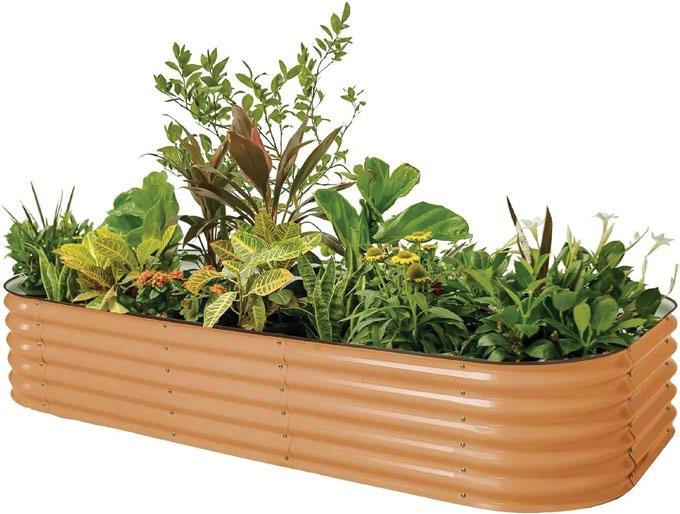
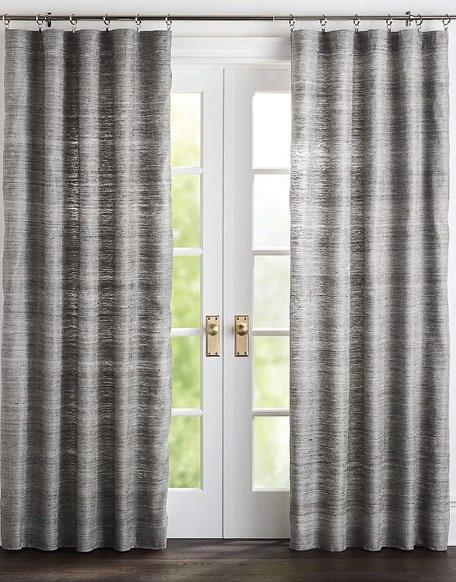
Thermal drapes, like Crate and Barrel’s Silvana Blackout Curtains, block sleepdisrupting sunshine and lower energy consumption. Made with a blend of pure silk and linen yarns on the front and a 100% polyester liner, they are an excellent choice for energy-efficient, passively cooled spaces.
USD140, crateandbarrel.com
If you’re short on space in your balcony, yard, or garden, the Vego raised planter is a great solution. Made from aluminium-coated steel, the raised bed kit can be easily assembled without any prior construction knowledge. The planter offers nine different configurations to fit most spaces.
From USD169.95, vegogarden.com
Who says your plants must stay outside? In West Elm’s Pure Ceramic Planters, their colours come alive indoors against the planters’ crisp matte white finish and fluid lines. These watertight, Vietnam-made earthenwares come in three sizes, one spacious enough to accommodate a monstera or small tree.
Up to USD149, westelm.com


Candles can be unsustainable, but candlemaker Siblings devised a canny workaround: a handmade, ceramic “forever vessel” that can be refilled with the company’s signature wax. It’s an aromatic blend of coconut and soy wax infused with non-toxic, cruelty-free fragrances and essential oils.
From USD69 (starter set), siblings.co
Embrace the future of urban living at TOPSIDE RESIDENCES where every day is lived at the top

As cities expand, they often spread horizontally, leading to urban sprawl and the loss of natural areas. To combat this, many urban planners advocate for vertical development.
A “vertical city” can house homes, retail spaces, and workplaces within a single tower, offering an eco-friendly alternative that preserves natural habitats. This concept works towards the philosophy of sustainable cities and communities, which forms one of the United Nations’ key Sustainable Development Goals (SDGs) for 2030.
TOPSIDE RESIDENCES represents Hong Kong’s exceptional showcase of a vertical city development. This project by leading HKSE-listed property developer CSI Properties is more than just a building; it is a rare development in Hong Kong integrating residential, office and retail use in a single landmark tower.
Designed by acclaimed British practice Studio PDP, TOPSIDE RESIDENCES is a unique architectural feat with a winning tri-factor: It features a high-speed rail connection, high altitude, and an elevated “clubhouse in the skies”.
In other words, TOPSIDE RESIDENCES delivers a lifestyle of “Living high up top, with the HSR at your door”.
TOPSIDE RESIDENCES stands out for being the nearest brand-new residential development to the West Kowloon High-Speed Rail (HSR) station. Situated within the Hong Kong High-Speed Rail (HSR) Arts & Cultural Hub, TOPSIDE RESIDENCES is a mere 4-minute drive from the HSR station.
TOPSIDE RESIDENCES stands in the very core of Hong Kong where the city’s principal transport links are; its site boasts the city’s highest coverage of MTR lines. Located along renowned Nathan Road, the main thoroughfare
of Kowloon, the project serves as the fabric that connects the urban community and the key to restructuring this popular neighbourhood.
It is also just a stone’s throw away from International Gateway Centre (IGC), a recently named HKD40billion commercial development set to become a transport hub for major rail lines in the city. Set atop the West Kowloon station, IGC will be home to the headquarters of first-class international corporations such as UBS and Ping An Insurance.
TOPSIDE RESIDENCES is also a oneof-a-kind development because it is composed entirely of “upper-floor only” residences. The homes are elevated atop a premium office-retail complex, presenting an exclusive degree of privacy over a breathtaking panorama of the Victoria Harbour skyline, Hong Kong’s most coveted view, in selected units.

TOPSIDE RESIDENCES is undoubtedly the ultimate investment for those looking to own a lifestyle with this prestigious vista from a brandnew landmark in the heart of Hong Kong. TOPSIDE RESIDENCES offers 259 premium residential units with spacious saleable areas (ranging from 232 sq ft to 1,589 sq ft). Units come in various types from one- to threebedroom units to special units and penthouse units with private rooftops.
CLUB TOPSIDE, the tower’s clubhouse, is a rare gem in the neighbourhood. This clubhouse in the sky showcases the best of urban resort living with Lake of Bliss, an infinity pool allowing swimmers to take in spectacular vistas of the Hong Kong skyline. The
clubhouse also includes a villa-inspired pool house made for parties and relaxation.
CLUB TOPSIDE additionally has a pair of fitness zones: Ground of Toughness, an open-air, outdoor restorative zone, and Arena of Persistence, an indoor active zone.
Adjacent to Diocesan Girls’ School, TOPSIDE RESIDENCES is nestled in an eminent neighbourhood with a historical legacy. TOPSIDE RESIDENCES is in one of the world’s largest cultural hubs, the West Kowloon Cultural District, with a high concentration of landmark amenities and lavish, private members’ clubs.
Given its top-tier location and accessibility, TOPSIDE RESIDENCES rides on boundless real estate investment potential. As part of a centrally located, well-connected district, TOPSIDE RESIDENCES is a captivating address for young professionals and highly qualified expatriates from China and abroad. It also suits end users with families.
TOPSIDE RESIDENCES exemplifies CSI Properties’ winning strategy of developing core districts in cities like Hong Kong, Shanghai, and Beijing and creating properties with high capital value.
In addition to TOPSIDE RESIDENCES, CSI Properties has developed the luxurious projects DUKES PLACE and 8 PEAK ROAD, as well as the Grade-A office building HARBOURSIDE HQ and retail centre 92 Wellington Street Central.
In conclusion, TOPSIDE RESIDENCES offers a remarkable lifestyle with its unique vertical development approach, combining luxury, convenience, and sustainability. Its peerless location, coupled with luxe amenities and access to transportation hubs, makes it an ideal choice for those seeking a modern but eco-conscious living experience—with Hong Kong’s iconic skyline as the backdrop.



In the Philippine province of Batangas, LIMA Estate models a citywide vision that uplifts workers while appealing to climate-conscious employers
BY AL GERARD DE LA CRUZ

In the Philippines, a paradox beckons to enterprises: a modern industrial development that benefits the environment.
LIMA Estate, a township in booming Batangas province southwest of Manila, has become the country’s first industrial estate to clinch a certification for sustainability.
At 940 hectares, it is the archipelago’s largest privately owned industrial-anchored estate. The cool site, set around 300 metres above sea level between Lipa and Malvar, is a special economic zone with residential, commercial, and institutional uses.
LIMA Estate had sprung out of a 374-hectare industrial park, formerly a joint venture of local developer Alsons Land Corp. and Japanese firm Marubeni Corp. Aboitiz InfraCapital Economic Estates, the infrastructure division of conglomerate Aboitiz Group, fully acquired the site in 2014.
The company looked to replicate the success of West Cebu Estate, a seaside industrial park that it turned into one of the country’s major shipbuilding centres.
“Property development in the Philippines is not for the faint of heart,” says Rafael Fernandez de Mesa, head of Aboitiz InfraCapital Economic Estates. “It’s quite challenging to acquire land, to have it permitted, to plan, and to construct it. But we had been doing it over the past 30 years, so we had a solid team that was very focused on how to get it done.”
With design firm AECOM Philippines on board, LIMA Estate is master-planned to incorporate diverse housing solutions from worker dormitories to mid-income and executive homes. Along with architecture firm PGAA Creative Design, AECOM has allocated a high ratio of open spaces to the estate, propagating local species.
The residences speak to a harsh reality in the Philippines: Industrial employees often face long commutes that impact their quality of life. LIMA ESTATE, THE PHILIPPINES’ LARGEST PRIVATELY OWNED INDUSTRIAL ESTATE, HOSTS PHILIPPINE ECONOMIC ZONE AUTHORITY (PEZA) AND BUREAU OF CUSTOMS (BOC) OFFICES, FACILITATING CONNECTIONS BETWEEN BUSINESSES, COMMUNITIES, AND THE GOVERNMENT
THE ESTATE HAS ATTRACTED 179 COMPANIES, INCLUDING EPSON BELOW, AND SUPPORTS A WORKFORCE OF 71,000

“Our inspiration was, ‘How do we improve the lives of these people?’ The solution was to bring housing inside,” says Fernandez de Mesa. “At the same time, we’re contributing to sustainability because we’ve reduced the number of trips. Now that the worker has a better life, it’s easier for locators to attract talent, retain that talent, and make that talent more productive. It’s a multi-pronged benefit from one solution.”
To prove its commitment to climate action, Aboitiz InfraCapital responded several years ago to the Philippine Green Building Council’s call for participants in a pilot programme to certify districts. “When nobody wanted to take a risk, they did it,” notes the council’s chief executive Christopher Dela Cruz.
The collaboration culminated in LIMA Estate achieving the 5-Star Building for Ecologically Responsive Design Excellence (BERDE) District Certification in 2022.
“You can imagine how much information there is to gather in a development with 900 hectares,” says Fernandez de Mesa. “The challenge was to put all the information together, but once we were able to do that, it became very evident how we were already a very sustainable development.”
Approximately 21% of LIMA Estate’s energy supply is sourced from renewables. LIMA EnerZone, which generates and distributes power in the estate, is part of AboitizPower, one of the Philippines’ major renewable energy suppliers with an array of hydroelectric, geothermal, solar, and thermal facilities nationwide.
“That gives us a level of expertise instantly,” says Fernandez de Mesa. “Other than providing a solution of locating in a place that draws energy from renewable sources, we can also offer advisory services to locators on how to run their facilities and their equipment more efficiently to reduce power consumption.”
NOW THAT THE WORKER HAS A BETTER LIFE, IT’S EASIER FOR LOCATORS TO ATTRACT TALENT, RETAIN THAT TALENT, AND MAKE THAT TALENT MORE PRODUCTIVE. IT’S A MULTIPRONGED BENEFIT FROM ONE SOLUTION
MOST INDUSTRIAL LOCATORS IN THE ESTATE, ALONGSIDE DEVELOPMENTS IN ITS CENTRAL BUSINESS DISTRICT, USE SOLAR ROOF-MOUNTED SYSTEMS, COLLECTIVELY GENERATING 21.5 MEGAWATTS OF POWER
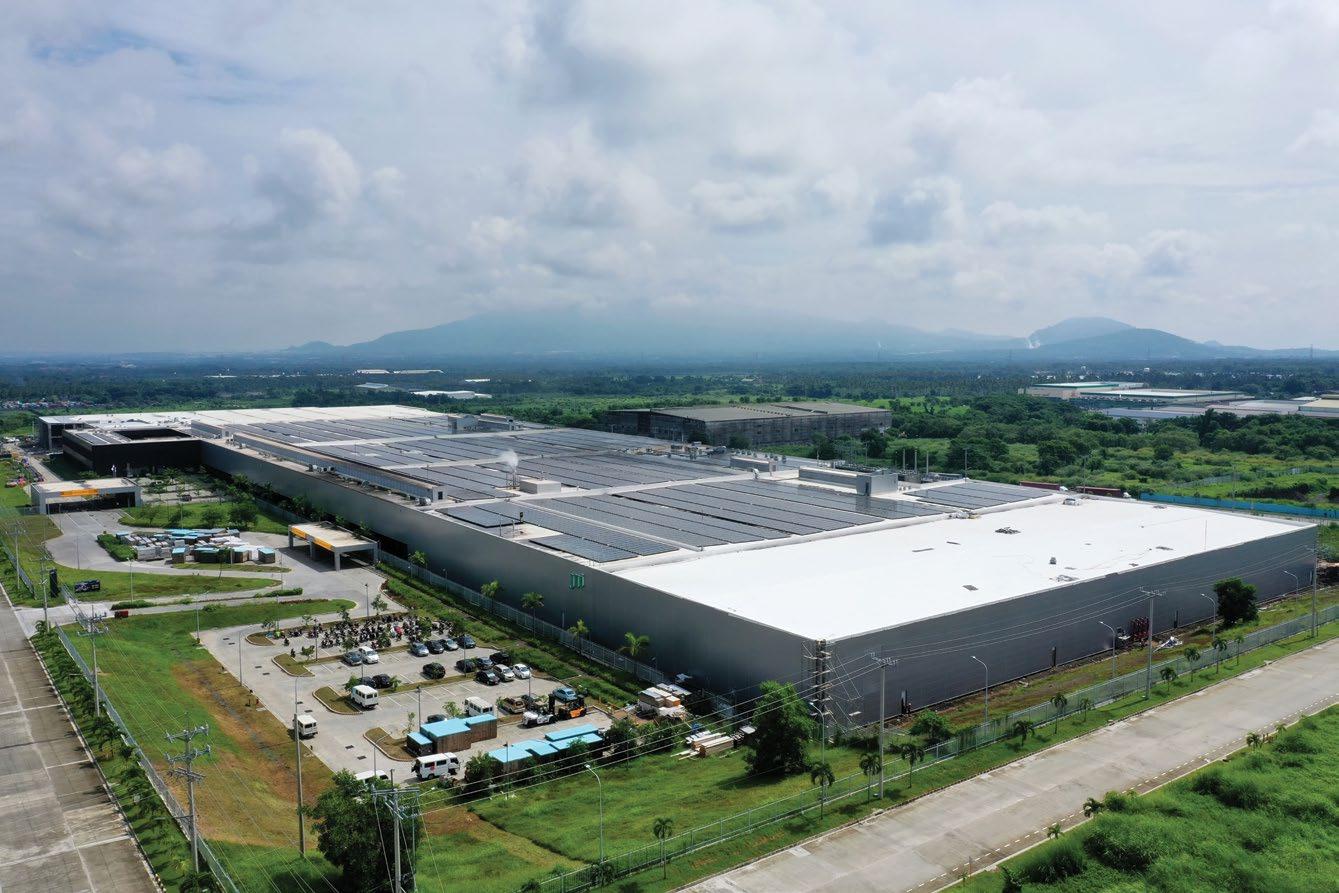
ONE OF THE PHILIPPINES’ LARGEST OUTDOOR MALLS, THE OUTLETS AT LIPA OFFSETS AS MUCH CARBON DIOXIDE ANNUALLY AS PLANTING 1.4 MILLION TREES

A substantial chunk of LIMA’s total power demand derives from contestable customers who source 19.26 megawatts of renewable energy from AboitizPower’s Retail Electricity Supplier. The estate’s 30-hectare central business district utilises 63% off-site renewable energy.
The rooftops across LIMA Estate have a footprint large enough to support solar panel systems capable of generating a total of 21.5 megawatts of power. The Outlets at Lipa, an outdoor shopping mall within the CBD, features a 1.5-megawatt-peak (MWp) rooftop solar panel system that offsets 31,000 tons of carbon dioxide every year.
LIMA Water recently mounted a sewage treatment plant with solar panels capable of generating 146-megawatt hours (MWh) of power annually. The subsidiary of Aboitiz InfraCapital has reduced non-revenue water to just 5%, well below the ecozone authorities’ acceptable level of 20%, through various programs.
Also, the national environment department has authorised LIMA Water to operate a laboratory that tests water quality and effluent for the estate and communities beyond.
“We are, in essence, almost practically a city,” says Fernandez de Mesa. “We’re running all the services that a city would run.”
The construction arm of Aboitiz Group utilised rocks and other naturally occurring materials onsite to build retaining walls and waterway enhancements. The choice of precast systems also featured recyclable materials while plastic waste was collected from locators for conversion into useful eco-bricks.
A circular economy is still at play in the estate. Aboitiz InfraCapital recently equipped its sustainability centre with a food waste composter, producing fertiliser for farmers living nearby.
Decarbonisation efforts are making headway with Aboitiz InfraCapital converting the estate’s public vehicles to pointto-point electric buses, powered by LIMA EnerZone’s fastcharging EV stations. The transition to non-fossil-fuelled transport should be completed by 2025.
Aboitiz Data Innovations, the Group’s Singapore-based tech startup, has partnered with consultancy Surbana Jurong to develop an intelligent roadmap for the estate. This has led to the establishment of a central command centre, alongside state-of-the-art cameras, that collects data across the estate.
These initiatives respond to growing consumer demands for genuine commitment over greenwashing. “Sustainability
THE PROJECT’S DECARBONISATION EFFORTS INCLUDE REPLACING FUEL-POWERED VEHICLES WITH EVS, SUCH AS THIS FLEET OF ELECTRIC MINIBUSES, PROVIDING SUSTAINABLE INTRA-ESTATE MOBILITY TO THOUSANDS

and smart technology are really at the top of the list of what companies are looking for because their stakeholders are requiring it of them,” says Fernandez de Mesa.
A supporter of the government’s overseas trade missions, LIMA Estate has attracted 179 companies, representing around 71,000 workers. Locators span light to medium industries, primarily in electronics, automotives, food, and consumer goods.
Aboitiz InfraCapital truly aims to “create employment opportunities for fellow countrymen,” notes Clifford Academia, vice president for operations at LIMA Estate. This year, Japanese clutch manufacturer Ogura relocated its operations from Laguna province to the estate, with company president Toshio Takahashi lauding its “comprehensive infrastructure development solutions.”
LIMA Estate will double its size to 1,500 hectares over the next decade, with a current 110-hectare industrial expansion
underway. Having rapidly sold out its initial phase of commercial lots, the estate’s business hub is gearing up for a 40-hectare expansion, slated to begin in 2024. Last year, the government approved Proclamation No. 204 designating several parcels of land in Malvar for the estate’s expansion.
Fernandez De Mesa acknowledges that the hardworking Filipino workforce is the “lifeblood” of industrial development as he looks to the next eras of the estate’s growth.
“At the end of the day, our customers are from around the world, and they have many choices of where to locate their businesses,” he says. “When we look at who we’re competing against, we’re not necessarily looking in the Philippines. We’re actually looking at the region. And it’s important for us to be able to stay ahead of trends and address the needs of our customers.”

LIMA Estate’s ascendance comes as the Philippines attempts to court more foreign direct investments (FDI). Last year, the country received USD8.9 billion in net FDI inflows, exceeding the government’s USD8billion target.
Leaders at Aboitiz InfraCapital Economic Estates, the infrastructure arm of Aboitiz Group, occasionally travel abroad with government officials to promote the country’s growing industrial base and young, competent workforce.
When companies express interest in visiting the Philippines, Aboitiz collaborates with the government to provide tours for these potential investors.
“We’re very happy to see how the national government has been making a lot of efforts to make investment in the Philippines more attractive and
how they’ve been very proactive to go and spread the word and generate awareness about the Philippines,” says Rafael Fernandez de Mesa, head of Aboitiz InfraCapital Economic Estates. “We see ourselves as a partner in what they’re trying to do, by providing the facilities of a world-class level for those investors that want to come to the Philippines.”
LIMA Estate complements another ambitious Aboitiz InfraCapital project, TARI Estate in Tarlac province. Together, the estates support the Luzon Economic Corridor, a government initiative to strengthen supply chains and stimulate industry on the Philippines’ biggest island.

As head of sustainability at PropertyGuru Group, Cecile Corda has helped launch innovative new programs to help property seekers make more considered choices
BY BILL CHARLES
CECILE CORDA BELIEVES THAT SUSTAINABLE DEVELOPMENT IS THE CORNERSTONE OF CREATING A RESILIENT REAL ESTATE INDUSTRY


We hope to encourage property seekers to choose homes with relevant sustainability characteristics, recognise sustainable housing projects and developers, and raise awareness around lower-impact living
As the head of sustainability at PropertyGuru Group, Cecile Corda understands the importance of promoting eco-friendly changes in the real estate sector—an industry which, she is quick to point out, is responsible for about 40% of global carbon dioxide emissions.
“Sustainable development is the cornerstone of creating a resilient real estate industry,” she says. “Our expertise, coupled with proprietary data and advanced analytics, positions us to offer innovative solutions essential for developing the cities of tomorrow.”
Under Corda’s leadership, PropertyGuru has ramped up its sustainability initiatives, while injecting fresh energy into existing ones and launching innovative new programs. Among these, the “Green Score” stands out, offering property seekers a unique tool to evaluate
PROPERTYGURU INTRODUCED ITS ‘LIVEABILITY INDEX’—A METRIC WHICH ASSESSES A WIDE RANGE OF SUSTAINABILITY FACTORS—IN MALAYSIA

homes based on their sustainable features, empowering them to make choices that reflect their commitment to environmental responsibility.
Another notable initiative is the “Liveability Index,” introduced in Malaysia, which assesses a wide range of factors contributing to vibrant and sustainable living environments. The sustainability categories at the PropertyGuru Asia Property Awards continue to spotlight and reward exemplary eco-friendly projects, inspiring real estate developers to pursue and prioritise sustainability in their developments.
Corda, from France, is a longtime sustainability advocate in Asia. She has been instrumental in providing both technical and strategic support to companies striving to improve their ESG performance and manage climate change risks. Her efforts are geared towards guiding these companies in their transition to a low-carbon, sustainable economy.
By promoting international best practices, she helps organisations build a strong business case for environmental change, covering a broad spectrum of areas including climate
mitigation and adaptation, protection of natural capital, the circular economy, plastic reduction, sustainable and ethical supply chains, innovation, and sustainable finance.
“Our ‘Gurus for Good’ strategy is central to delivering our vision, driving us to excel both as a business and a socially responsible leader. We’ve poured our hearts into understanding what people need and then turning those insights into action,” she says.
An increasing number of property seekers are looking for more sustainable homes. The demand for sustainable housing is driven by the belief that it’s the right thing to do. Another driver is that the cost of living in, and powering, homes is increasing.
PropertyGuru Green Score was launched in 2021 in Singapore, and it empowers people to make more informed decisions by highlighting sustainable credentials of properties. Our Green Score uses two metrics to assign a sustainability rating to

listings on our platform in Singapore. The first metric relates to the number of rapid transit stations and bus stops. The closer the property is to a transportation hub, the higher the score.
The second metric is the number of sustainability awards won (for example, the BCA Green Mark certification) by the development. Each of these metrics receives a rating from 1 to 5, with 1 being “average” and 5 being “excellent.”
By displaying the Green Score on our listings, we hope to encourage property seekers to choose homes with relevant sustainability characteristics, recognise sustainable housing projects and developers, and raise awareness around lowerimpact living. This will stimulate developers and the real estate industry to prioritise sustainability when researching, developing, and innovating new products and buildings.
What is the idea behind the Liveability Index?
The value of a property comes from more than just its price, size, and accessibility. We have identified that there is also
intrinsic value in aspects like the sense of community, mobility, and sustainability. For us, liveability is based on how well those factors serve communities in a certain area.
PropertyGuru has developed a liveability index, transforming powerful data sets to guide insight-driven decisions within the real estate industry. What sets our liveability index apart is that it uses our proprietary data, offering insights right down to the building-project level rather than at the city level. It provides our customers with a level of granularity and localised insight both into rural and urban areas.
The index has five categories: housing affordability and quality; availability and accessibility of amenities in neighbourhoods; factors affecting our natural environment such as air quality, flood, and heat risks; quality of public transport infrastructure to enable mobility; and employment opportunities offered by economic activity.
It can be used to analyse existing neighbourhoods for benchmarking and opportunity identification or to help prioritise aspects of development during the planning stages.

Developers, urban planners, and policymakers can use it to identify tangible opportunities to improve the liveability of an area or a project. For instance, if an area is missing certain desired public amenities, township developers and local governments can work together to develop those.
If a planned project does not measure up against the rest of the neighbourhood, it can pinpoint areas of concern and enable careful scenario modelling and proactive management strategies.
What are some of PropertyGuru’s recent initiatives to help address climate change in the region?
Southeast Asia is expected to be one of the regions the most impacted by climate change. We already see its consequences with more frequent and intense storms, flashfloods, and extreme heat. Finding ways to predict and adapt to climate impacts will help futureproof the real estate sector and PropertyGuru has a key role in this.
Thanks to the climate risk insights we provide, our customers can take better account of the impact of climate change on their projects and assets. They can make informed decisions and improve their investment strategy.
For example, in Malaysia, the combination of development processes, urban planning, and annual monsoons makes properties particularly susceptible to recurrent flooding something we’re seeing increasingly regularly.
As many of our customers are based in Malaysia, data insights could play a pivotal role in shaping their development and investment strategies, driving the integration of climate change adaptation and mitigation measures into their projects.
Since 2023, we have partnered with Intensel—a climate risk software solution company—to provide risk analysis to our customers. By combining satellite imagery with climate modelling and our proprietary data, we offer climate insights relevant to our customers’ specific locations. It

offers advantages whether you’re an agent, property seeker, developer, or someone purchasing land or a building.
How does recognition, including at the Asia Property Awards, help drive positive change?
The Asia Property Awards recognise and reward the finest real estate and sustainable best practices. Responsible development has become much more of an industry focus. With this evolution, we’ve seen a greater understanding of the role sustainability should play in the real estate industry. The sustainability awards create an opportunity to educate and engage developers on this journey.
But while it’s true that understanding is on the increase, progress isn’t necessarily happening uniformly across markets. For example, to qualify for the Green Development award, projects must be certified by an international green certification body. The Best Eco-Friendly Development award category was added to reward green projects that have not yet applied for accreditation or have no
access to the application. We also created our Special Recognition awards to encourage developers who commit to Environmental, Social and Governance (ESG), Corporate Social Responsibility, Sustainable Design and Construction, or Building Communities.
Delivering impact is also about creating space for diverse voices. We host the annual Asia Real Estate Summit, which promotes diverse speakers, topics, and panels. This includes recognising outstanding women leaders who are blazing a trail in our industry.
The sustainability awards, and the summit are about highlighting both environmental and social impacts. We recently created a separate prize—the PropertyGuru Visionary Award—which honours individuals who deliver remarkable, innovative community benefits and inspire positive change. In 2023, we gave this award to the climateresponsive architect Vinu Daniel, founder of Wallmakers, for his sustainable designs using mud and debris.

Fusing a Thai background with extensive time in the West, Sasivimol Sinthawanarong has forged a unique architectural identity via JARKEN, her award-winning practice
BY LIAM ARAN BARNES
Sasivimol Sinthawanarong received two pieces of wisdom on the day she started university. The first was from a professor welcoming the new students with advice on splitting their day into three eight-hour windows for study, socialising, and sleep.
The second came immediately after from her department head, who apologetically explained that school life for architecture students was more likely to be “work, work, and work”.
“Architecture is a very demanding profession,” Sasivimol says. “You must forget about weekends, making plans with friends is just a bad idea, and sleep is a luxury.”
Despite these downsides, the co-founder and principal at JARKEN adds that she cannot imagine enjoying anything more than immersion in her chosen field.
After earning her bachelor of architecture from Chulalongkorn University in Thailand, she pursued a post-graduate diploma in Interior Design from Milan’s Domus Academy and a postgraduate diploma in Design Management from Parsons in New York. Fresh from her studies, Sasivimol launched the award-winning JARKEN in 1999 and has seemingly not stopped since.
What started as just two people has grown into a multidisciplinary firm with a staff of more than 100, providing architectural, design, and construction services, as well as branding and consulting. Based in Bangkok, the teams primarily work with overseas clients across residential, commercial, and hospitality projects, instilled with a simple philosophy of “bridging art and design”.
“Art creates questions, design creates answers,” Sasivimol says. “Design solves problems and meets needs. We strive to create architecture and design rooted in reality, aesthetically pleasing, delightful for those who encounter it, and uniquely tailored for different people.”
This approach has garnered JARKEN numerous accolades over the years, including recognition as one of Asia Pacific’s most promising young interior designers by the World Federation of Interior Architects in 2009.
The firm received the Design for Asia Award in Hong Kong in 2017, honouring outstanding design projects across various disciplines. The D’Luck Cinematic Theatre project was also shortlisted for the World Festival of Interiors in the Civic, Culture & Transport category in the same year.
JARKEN has also been awarded the Singapore Good Design Mark Award in the Social Communication Category and the IAI Design Award Asia 2015 for its commercial endeavours.
SASIVIMOL SINTHAWANARONG HAS FUSED A REVERENCE FOR ASIAN DESIGN TRADITIONS WITH EXTENSIVE EXPERIENCE IN THE WEST IN HER WORK

We strive to create architecture and design rooted in reality, aesthetically pleasing, delightful for those who encounter it, and uniquely tailored for different people
And the firm’s ability to adapt to new trends and client expectations has been crucial to this success. It has transformed from a small operation into a structured system, continually embracing new clients, technologies, and methods of client interaction.
“Every year is a milestone,” Sasivimol says. “We continuously grow and adapt to meet the needs of new generations of clients.”
A pivotal project highlighting this evolution was its first hospital design. Leading a team that included experienced doctors, specialists, and technicians, JARKEN navigated the complexities of healthcare design with a blend of humility and determination.
It learned and adapted on the go, to deliver a project that has since established JARKEN as a specialist in the field.
“Taking on the hospital project was a significant challenge,” Sasivimol recalls. “But it also proved to be one of our most rewarding endeavours, pushing us to new heights and solidifying our expertise in this niche.”
Sustainability is another key component of JARKEN’s philosophy. Since its inception, the firm has implemented Leadership in Energy and Environmental Design (LEED) and green design practices, ensuring projects are both innovative and environmentally responsible.
A prime example is the “Private Modern Residence” project, where the team adopted a minimum-waste approach, combining existing infrastructure with new, lightweight materials to create an eco-friendly living space.
This project embodies a green design approach, prioritising non-invasive methods and environmental harmony, according to Sasivimol. “Environmental awareness significantly impacts society and the environment. It reduces design costs, fosters innovation, and benefits clients who value sustainability.”
Combining her Eastern background and Western experiences, Sasivimol continues to refine an approach that fuses the ideals of both worlds. She emphasises the importance of understanding clients’ needs, whether for residential projects, where she delves into personal details to tailor the design, or commercial projects, where identity is key.
“It’s crucial to know our clients’ characteristics to create spaces that enhance their quality of life, especially for residential projects,” Sasivimol explains. “For commercial properties, our research-driven approach ensures we meet organisational needs effectively.”
Looking ahead, Sasivimol hopes to continue developing the newer disciplines of the company, including fashion and product design, and most recently the branding agency, alongside the highly successful architecture and design business. Indeed, more than a quarter of a century on from that first day at university, it seems Sasivimol has never quite shaken that “work, work, work” mantra.
“Despite the demands and challenges, architecture has always been my passion,” she says. “It’s a profession where the balance of art and design continually inspires and drives us to create spaces that meet needs, but more importantly enhance lives.”



The Singha D’Luck Cinematic Theatre marries the concept of magic illusions with authentic Thai craftsmanship. The stage features a simple curtain backdrop depicting mountains, forests, and battlefields, the main themes of the performances. Sustainability was a priority, with JARKEN adhering to LEED guidelines and using primarily local materials.
Key design elements include textured black stone walls and a dynamic interior façade and ceiling, creating a tunnel-like flow. The main theatre embellishments enhance live shows and CG effects, with dark-toned, soundproof materials covering the seats and stage. Meanwhile, the ticket office and souvenir shop, inspired by Thai literature, feature semimirrored floors and curved hidden lighting, simulating a river leading into the theatre.
“The lobby is the most dramatic part of the 4,000-squaremetre space,” notes Sasivimol. It includes a restaurant, rest area, and themed souvenir shop, surrounded by pillars of LED screens and illusion sculptures. “This area was designed to captivate visitors from the moment they enter, setting the tone for the immersive experience inside the theatre.”



SLC Clinic, Bangkok
The design philosophy embodies a fusion of fresh, modern, and contemporary styles focused on beauty and art. This approach weaves a narrative that echoes the style and embraces the essence of the space.
By incorporating textures, natural materials, and a minimalist lighting colour scheme, the design adds depth, sustainability, and lasting allure, creating a carefully curated palette that elevates the space, according to Sasivimol.
“Crafting spaces that feel like an extension of beauty is our design forte,” she explains. “Our designs honour the butterfly as a metaphor for personality, resonating with the building’s character and evoking the sophisticated vibes of quiet luxury. This approach ensures that the space looks stunning while also feeling like an extension of the beauty it represents.”



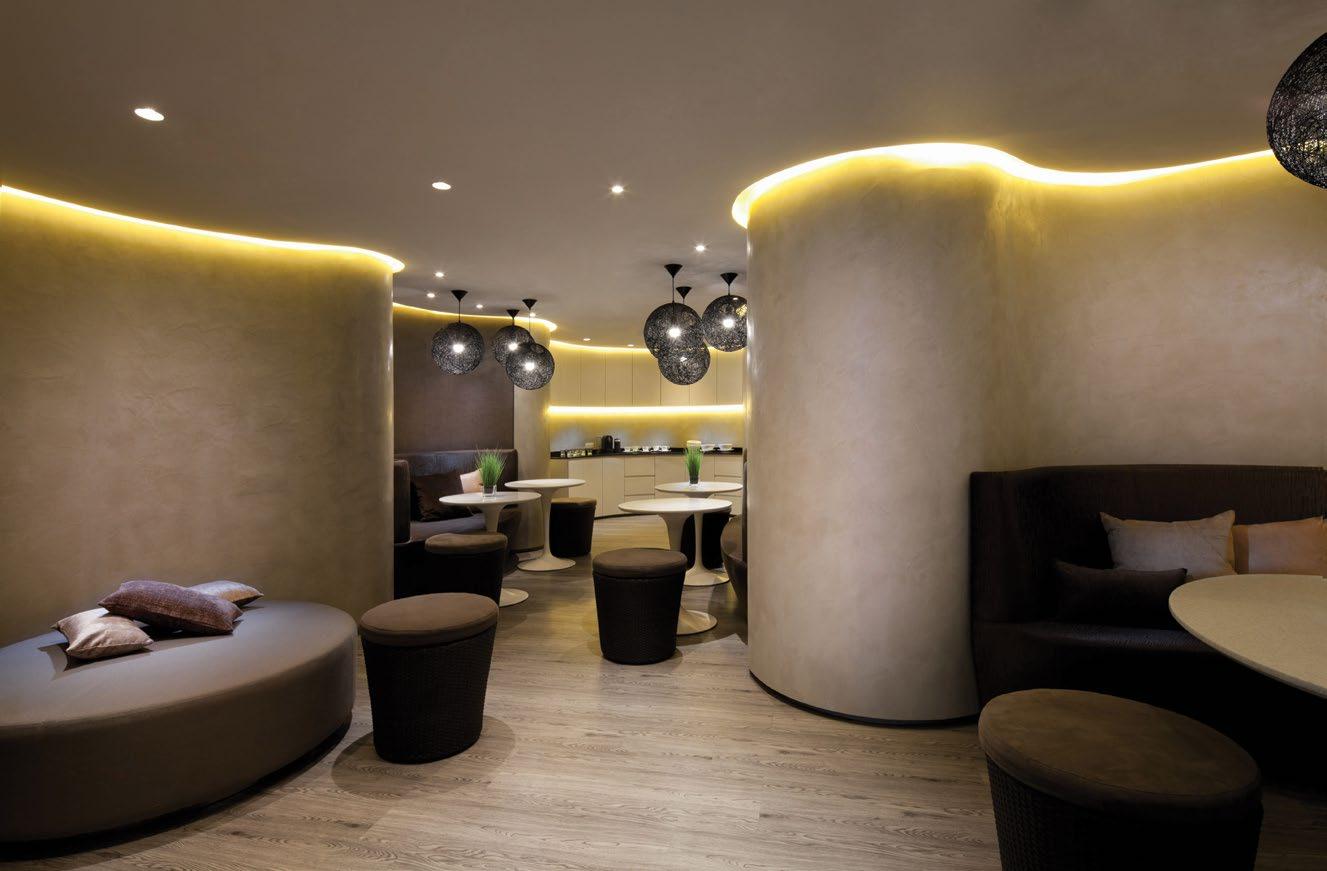
The conference room at CP Tower showcases a modern oriental interior design, blending Eastern and Western styles to transform a 30-year-old space into a stylish sanctuary. Emphasising natural materials, a muted colour palette, and soft lighting, the design fosters a sense of calm and tranquillity. The lotus leaf serves as the core motif, extending into every element of the space.
“We wanted to create a space that looked modern but also felt inherently peaceful,” says Sasivimol. “The use of natural materials and diffused lighting creates a serene environment, while the lotus leaf motif adds a touch of elegance and harmony, seamlessly integrating tradition with contemporary design.”

This private client project tackles the challenge of crafting a distinct identity for a contemporary boxy home by incorporating regionally sourced stone panel siding. The façade’s form and character showcase strong rectangular shapes juxtaposed with subtle curved lines and wood panelling, evoking a modern oriental ambience inspired by the thousand-year heritage of Feng Shui.
“Our goal was to create a residence that resonates with modern and traditional elements,” says Sasivimol. “We used regional stone and wood to craft a structure that feels timeless yet contemporary. The extensive windows and open design allow for a fluid connection between the indoor and outdoor spaces, providing a unique living experience honouring the cultural heritage.”
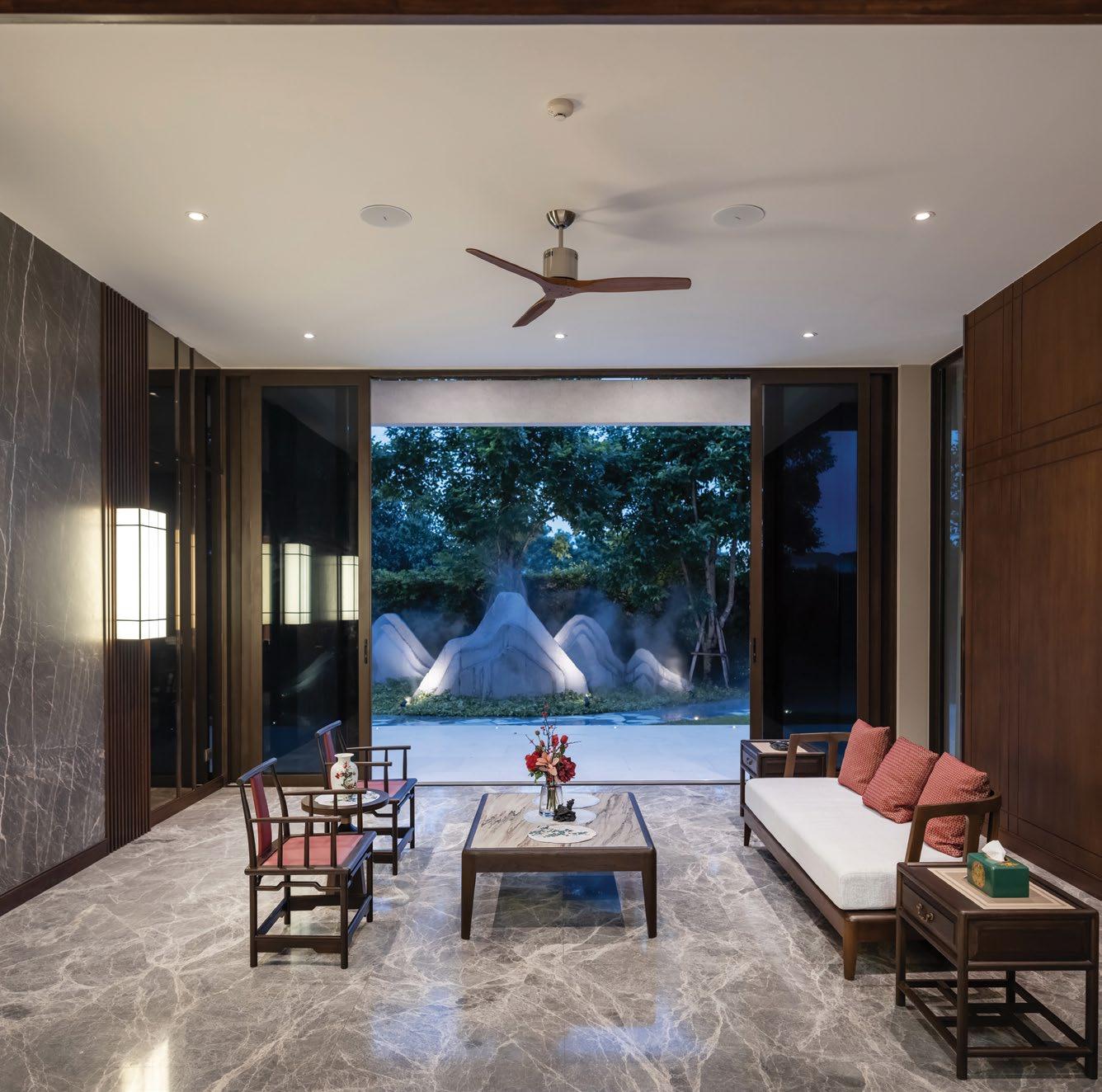


This two-storey house in the heart of Bangkok combines nature and luxury to create a modern residence and a comfortable nesting place. The standout design of the living space makes this home unique. The ground floor is designed to offer a relaxed environment while maintaining a connection with a semi-outdoor area that serves as a family gathering place.
This space features a large dining table and a food preparation area, making it a focal point for common activities. “We intentionally emphasised open, airy spaces and incorporated a semi-outdoor area to enhance family interactions. The ground floor’s relaxed design encourages communal activities and aims to strengthen family bonds.”
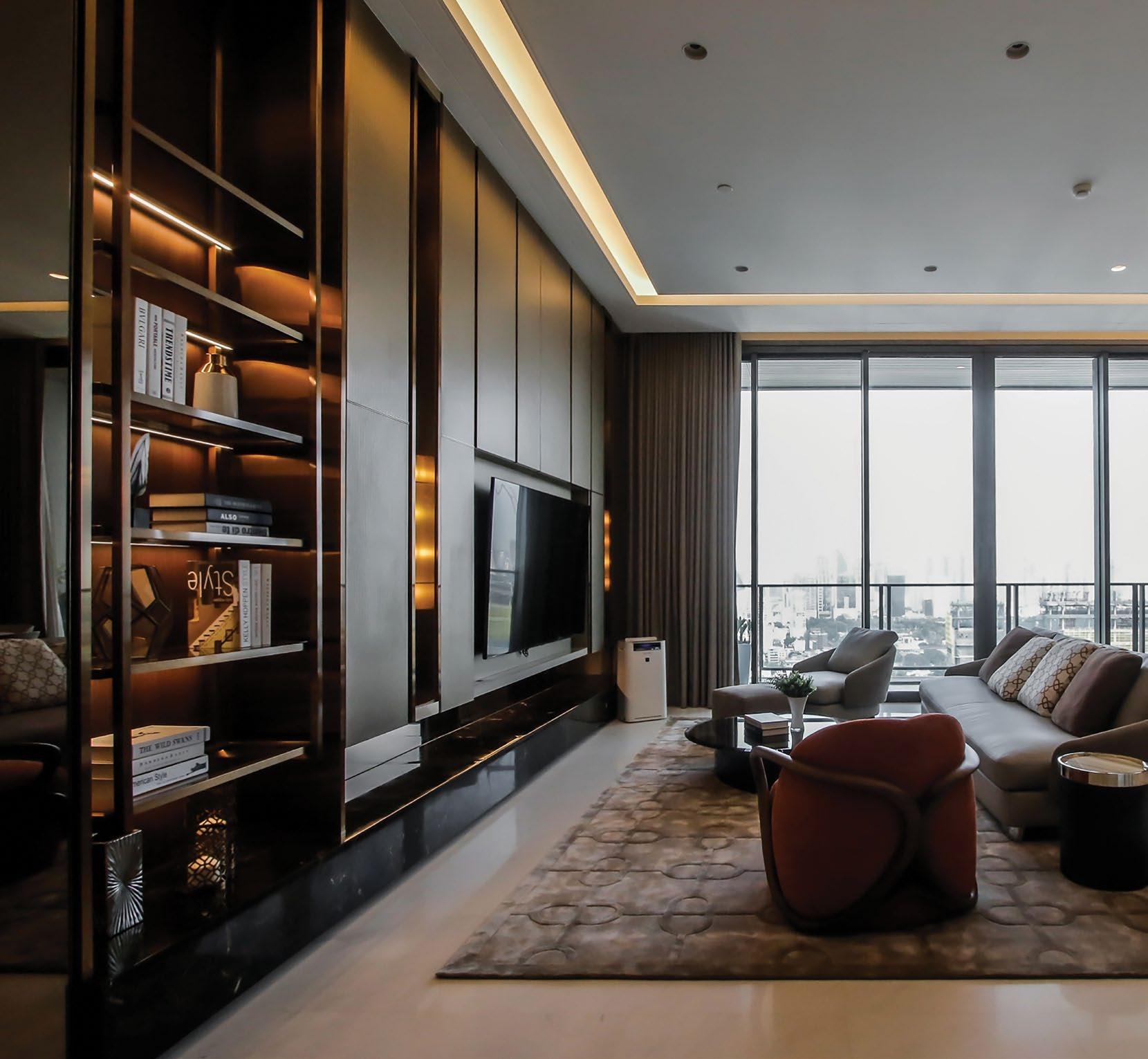


The design of The Residences creates a timeless look by incorporating elements that transcend trends and evoke elegance and sophistication. “The living space combines the grandeur and elegance of luxury design with the clean lines and minimalist sensibilities of modern styles,” Sasivimol says.
Traditional and new materials, like wood, stone, wallpaper, and metal fabric with stainless steel, add visual interest and depth to the design. Meanwhile, a neutral palette with subtle accents, including creams, whites, beiges, and soft pastels, provides a subtle backdrop, while pops of colour in upholstery, artwork, or accessories add a contemporary touch. “It’s this vibrancy that keeps the space feeling fresh and sophisticated,” Sasivimol adds.
With an outstanding location, great design, hyper-sized amenities, and sustainability features, Le Pont Residences bridges investors and property seekers to the finer things in life

Success is often measured by tangible symbols—luxury cars, designer watches, and trendy attire.
But status symbols come and go, and nothing timelessly embodies success like a high-end home. It offers people not just a comfortable lifestyle but also a statement of one’s achievements. Aside from validating one’s hard work, a prime home is a trusted store of wealth as well as a proven hedge against inflation.
RLC Residences, the residential division of award-winning developer Robinsons Land, has launched a high-rise, twotower condominium project designed to bridge property seekers to their best investment yet.
The property, set in a world-class location in the Philippine capital, represents prestige, glamour, and sophistication that wealth builders, overseas workers, and high-performing professionals deserve.
Le Pont Residences is situated within Bridgetowne Destination Estate, a burgeoning business district and lifestyle hub being developed by Robinsons Land. Residents can find an exclusive community of like-minded individuals in this 31-hectare mixed-use site, which connects Pasig and Quezon City via a 200-metre bridge designed by National Artist for Architecture, Francisco Mañosa.
The name of the development, “Le Pont”, is French for “The Bridge”, and it proposes connecting residents to their best lives. This address offers incomparable access to premier retail and commercial establishments, sustainable office buildings, and ample green spaces.
Residents can effortlessly seize opportunities and relish amazing moments, thanks to the development’s excellent connectivity to Metro Manila’s key destinations. Le Pont Residences is
nestled between two mega cities, Quezon City and Pasig, while Bridgetowne is the only estate in the area that has direct access to both cities. The development is also within easy reach via C5 Road, Ortigas Avenue, and Amang Rodriguez Avenue, all important thoroughfares in the Philippine capital.
Underscoring RLC Residences’ commitment to sustainable development, Le Pont Residences recently achieved the EDGE Advanced preliminary certification from the International Finance Corporation (IFC). The project features energy-efficient windows that make the most of natural light; landscaped open spaces blooming with greenery; and water-saving fixtures that promote resource efficiency.
Le Pont Residences is thoughtfully designed with excellence-defining features. Each one-, two-, and threebedroom flat, along with the topfloor units, are expansive and crafted

with materials such as porcelain, glass, and engineered wood. These premium materials not only enhance the aesthetic appeal but also ensure longevity and elegance. Every unit also boasts a loggia or glass-railed balcony while the top-floor units feature grand curved staircases and panoramic city views through full glass windows.
These units also combine beauty with functionality through smart home fixtures that make an intelligent livework-play lifestyle possible.
Beyond the private sanctuaries of the residences, the project offers an array of hyper-sized wellness and recreational amenities. Residents can keep their fitness levels in check daily at stateof-the-art gyms as well as indoor and outdoor activity areas. They can also enjoy swimming pools and private
function rooms, as well as a private theatre, work lounge, and game room. From the Infinity Pool as well as the Sky Lounge, residents and guests can admire a beautiful view of the estate, marked by the 60-metre public art installation known as The Victor.
These above-standard, multi-leveled facilities are strategically located across the towers, providing relaxation, recreation, and productivity. These amenities ensure that residents live exceptionally every day.
Le Pont Residences is tailored for high-achieving individuals, both in the Philippines and abroad, who are secure enough to indulge in necessities and luxuries. This high-end development suits those with a passion for premium experiences, combined with a desire to enhance or upgrade their assets.
Owning a unit at Le Pont Residences supports a lavish lifestyle and provides asset diversification. Investors can easily manage the units from the upcoming myRLC Home App, a first in the Philippine real estate industry with its in-app billing statements and online payment features, among others.
The launch of Le Pont Residences comes at an opportune moment for the Philippine economy. Since 2012, the economy has grown at an impressive average rate of 6% per year, excluding the pandemic period, and the country is on track to gain upper middle-income status soon.
Le Pont Residences captures this significant moment in the Philippine economy. As wealth increases in the Philippines, the project offers more than just a home but also a gateway to a community of high achievers. It’s a place where success is reflected in the exquisite surroundings and celebrated by accomplished individuals.
With these homes, property seekers can finally bridge the gap between their accomplishments and the lifestyle they desire so much.
At Le Pont Residences, you have not only arrived at an opulent address—you have, simply put, arrived.
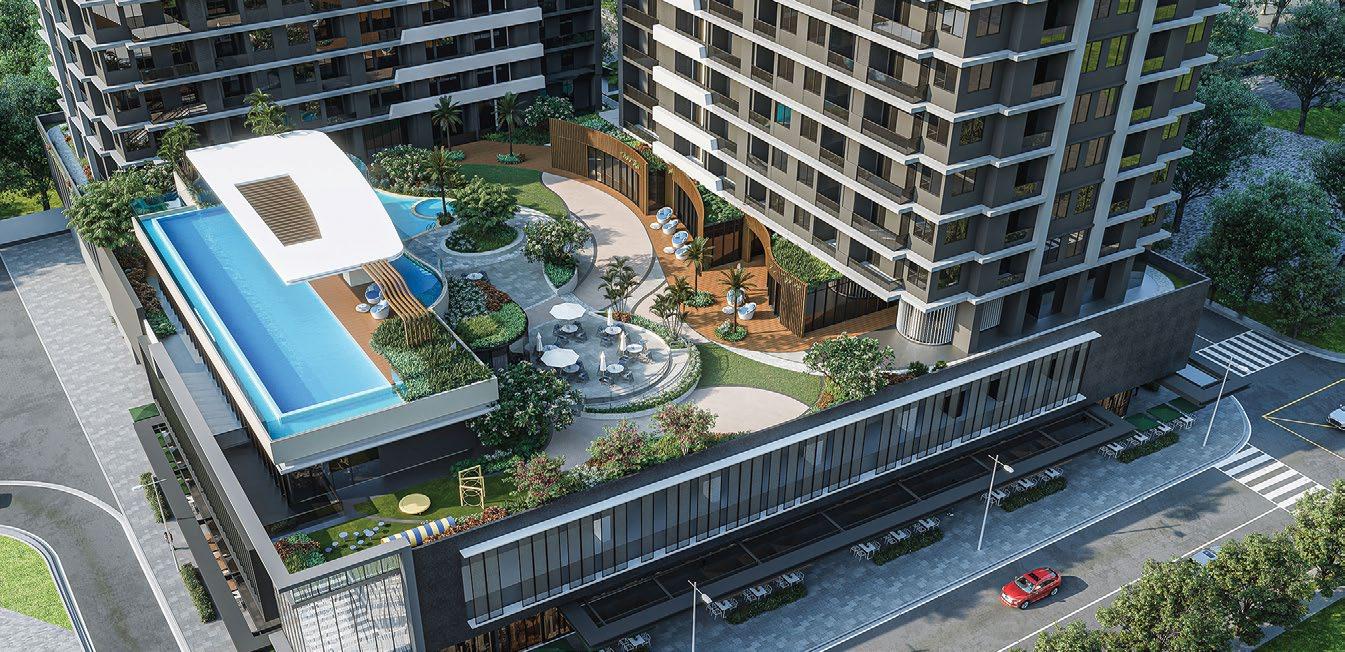
BY JONATHAN EVANS

The dynamic Bangkok enclave flaunts proximity to an international airport, top schools, and an impressive array of real estate investment options 1
Britania Bangna KM.39
This 232-unit project, scheduled for completion in Q4 2025, is a serene “wellness village” modelled on London’s modern, luxurious townhouses—two seemingly incompatible concepts juxtaposed in this tropical environment. The former element comprises indoor and outdoor areas beneficial to physical and mental health. There’s a two-acre wellness garden, jogging track, swimming pool with jacuzzi, fitness area, basketball court, stone-art healing garden, pet zone, library, and study room. There’s a small-scale replica of Big Ben and a windmill, design elements you don’t often see in Southeast Asian megalopolises. The development’s eco-friendly credentials include EV chargers and technology to combat air pollution.


2
A 29-storey high-rise comprising more than 1,400 units and a gym, Origin Play Sri Lasalle Station aims to circumvent the more functional tendencies of such largescale metropolitan buildings by introducing expressive interior design features from Paon Architect Ltd. These include paintings of landscapes and vibrant colours intended to inject vitality and passion into the lives of residents and provide a creative base for energetic Gen-Z urbanites living in a fastpaced society. While the award-winning, multinational Vector-Arch firm oversaw the architecture, local Thai company Redlandscape had a leading hand in creating the sizeable green space outside the condominium, which is replete with swimming pools and a rooftop sports area.
Mega Bangna
3
This giant shopping hub has become one of Thailand’s top shopping experiences, as well as Southeast Asia’s largest low-rise mall. It houses more than 800 standalone stores reflecting the international profile of its clientele, on top of 160 food outlets and anchor tenants including IKEA, hypermarkets, and a Mega Cineplex. Where it excels is in its elegant landscaping, ample indoor planting, and most of all, in its allages appeal: Children in particular gravitate to the ice rink, The Movement playground, and games arcade, while tourists enjoy the in-store service counter and VAT discount booklet. It might lack the novelty factor of a rooftop water park (like near-neighbour CentralPlaza), but Mega Bangna has the community appeal of the very best lifestyle malls.
Bang Na’s modern-day dynamism belies its agricultural origins. It’s a densely populated hive of activity covering every imaginable facet of life, from expos, F&B and retail to religion, entertainment, and education. Among its standout localities are Bangkok International Trade and Exhibition Centre, pioneering malls CentralPlaza Bangna and Mega Bangna, and a clutch of top international schools. It was also once home to the world’s largest restaurant. All these, combined with its proximity to Suvarnabhumi Airport, make Bang Na a prime catchment area for local and foreign families, resulting in fine recent exemplars of real estate.

Bangkok International Trade and Exhibition Centre
BITEC, as it’s commonly abbreviated, is a world-class MICE space opened in 1998— one of Thailand’s first such venues—and conveniently connected by a 500m “skywalk” to Bang Na BTS station. A vast public building, it has enough capacity within its 70,000-sqm floor area to serve 100,000 visitors a day. There are 10 exhibition halls, six convention halls, and 28 breakout rooms, as well as an office tower and convention centre. For 13 years, it played host to the Bangkok International Motor Show, the annual petrolhead display showcasing supercars and classic automobiles, but the breadth of its conventions is surprising. Most recently, BITEC hosted a giant furniture fair alongside Mission to the Moon, a forum describing itself as a “work-life survival guide”.

Built by refugees fleeing the BurmeseSiamese War in Ayutthaya in 1767, this historical religious monument counterbalances the rampant hypermodernity on show elsewhere in Bang Na. Originally constructed on an inaccessible canal, it was later relocated to the Chao Phraya riverside. Architecturally, the temple isn’t extraordinary, containing a Buddha image receiving offerings from an elephant and a monkey. But Wat Bang Na most famously contains the mummified corpse of Luang Pu Seng, a polyglot monk who completed the highest level of dharma studies (the Buddha’s teachings) in 1944, and whose amulets are said to bring good luck and protection. While his remains— he died in 1988—might appear somewhat gruesome for more delicate tastes, there’s no denying the monk’s spiritual importance to Thais.

Just across the river from Wat Bangna Nok Pier lies this desirable attraction—that rare Bangkok focal point for locals, rather than tourists, to escape their daily lives in a semi-rural location that isn’t gimmicky or pseudo-traditional, surrounded by lush forest. Like other floating markets, Talad Nam Bang Nam Phueng (literally, “place of honey”) is characterised by thatch-covered stalls selling everything from T-shirts to potted plants, but naturally, the emphasis is on local edible produce, from betel nut to an array of street snacks, and there are plenty of tables where customers can enjoy their Thai meats, satay, rice, or noodles. While not endowed with long-tail boats in the manner of Amphawa, Bang Nam Phueng is inexpensive, pleasantly sheltered from the sun, and authentic.


With governments around Asia rolling out policies to boost sustainable real estate, developers are being incentivised to push a green agenda into daring new realms
BY LIAM ARAN BARNES
SEVERAL ASIAN COUNTRIES, INCLUDING JAPAN AND SOUTH KOREA, HAVE SET AMBITIOUS NET-ZERO TARGETS FOR THE REAL ESTATE SECTOR

The Bosco Verticale turned 10 this year. One of the most feted buildings of recent times, Stefano Boeri’s masterpiece is a verdant sight to behold at the core of Milan’s concrete jungle.
The 116-metre skyscrapers, which the architect described as “a house for trees inhabited by humans,” gained global recognition for integrating more than 20,000 trees, shrubs, and plants. The “world’s first vertical forest” provides numerous environmental benefits such as improving air quality, reducing urban heat island effect, and fostering biodiversity.
A few years ago, Boeri repeated this feat with the Nanjing Green Towers in China. The project, which includes two 200- and 108-metre towers, continues the concept
by incorporating approximately 1,100 trees and 2,500 cascading plants and shrubs designed to absorb 25 tonnes of CO2 annually and produce about 60 kilogrammes of oxygen daily.
Still, the project was far from the first of its kind in Asia. The Oasia Hotel Downtown in Singapore, completed in 2016, exemplifies earlier efforts to integrate extensive greenery into high-rise structures. Designed by WOHA Architects, the hotel features a living façade covered in more than 20 species of creepers and vines, providing natural insulation and promoting biodiversity.
Similarly, Tree House by City Developments Limited, also in Singapore and completed in 2013, held the Guinness World Record for the largest vertical garden. Its expansive

24,638-square-foot green wall helps to reduce the building’s carbon footprint by filtering pollutants and minimising heat absorption.
While these projects are visually stunning and environmentally beneficial, they represent just a fraction of the ongoing efforts towards sustainable real estate in the region.
According to Kristin Thorsteins, chairperson of the independent judging panel for the PropertyGuru Asia Property Awards, there is significant momentum throughout Asia.
“Real estate markets are increasingly recognising the importance of integrating green practices, not just for
“Real estate markets are increasingly recognising the importance of integrating green practices, not just for compliance, but to meet the rising demand for sustainable living
compliance, but to meet the rising demand for sustainable living,” she says.
But Thorsteins also emphasises the need for more stringent regulations to propel sustainability efforts, similar to those in the EU and UK. “Stronger policies could drive a larger-scale adoption of green initiatives across the sector,” she adds. “If you look to other regions at the forefront of sustainability, punitive government legislations propelled integration of carbon-reducing initiatives in construction.”
Indeed, governments across Asia are rolling out policies to boost sustainable real estate. Singapore’s Green Building Masterplan aims for 80% of buildings to be green by 2030. In China, the Green Building Action Plan requires 50% of new buildings to be certified green by 2025.
Several Asian countries have also set ambitious net-zero targets for the real estate sector. Japan aims for net-zero emissions by 2050, with significant investments in green technology and infrastructure. South Korea plans to achieve carbon neutrality by 2050, focusing on green building standards and renewable energy integration. Furthermore, Hong Kong’s Climate Action Plan 2050 targets a 50% reduction in carbon emissions by 2035 and aims for net zero by 2050.
Despite the growing momentum, integrating sustainability into real estate development presents several challenges. The initial capital outlay for sustainable technologies and practices can be substantial, and the payback period, though often less than four years, can still be a barrier for some developers. Additionally, there is a need for a cultural shift within organisations to prioritise and champion sustainable practices.
“Investing in sustainable technologies not only reduces operational costs but also enhances the overall value and marketability of real estate projects,” says Charles Blocker, founder of real estate advisory firm IC Partners Limited. “However, developers must be committed to changing behaviour patterns and educating their teams to fully realise these benefits.”
He adds that emerging technologies will also be crucial in shaping this future. Innovations in energy management,
waste reduction, and building materials are set to transform how buildings are designed, constructed, and operated.
“Technology is the key to unlocking the full potential of sustainable real estate,” says Blocker. “From AI-driven energy management systems to sustainable building materials, these innovations will drive efficiency and sustainability in the sector.”
The increasing demand from investors for green-certified buildings is another positive sign. As Blocker points out, “Green projects are becoming essential for securing financing and attracting investors. This trend will continue to grow, making sustainability a core component of real estate investment strategies.”
Moreover, sustainability is becoming a significant factor in attracting and retaining talent. Companies with strong environmental credentials are more appealing to the new generation of workers who prioritise sustainability, according to Thorsteins.
“The values of the owners and the brand’s commitment to green practices make it easier to recruit and retain
employees,” she says. “This alignment between sustainability and corporate culture is vital for long-term success.”
This focus on sustainability enhances corporate culture while underscoring the broader need for systemic changes in the industry. Buildings like Bosco Verticale might capture the imagination and highlight the potential of integrating nature into urban living, but the widespread adoption of sustainable practices across the real estate industry relies more on robust policy initiatives and technological advancements. These elements, though less eye-catching, are essential in driving genuine industry-wide sustainability.
As Asia continues to embrace green policies and innovative technologies, the real estate sector can look forward to a future where environmental responsibility is the norm, not the exception. The blend of visionary projects and pragmatic strategies will ultimately shape a more sustainable and resilient urban landscape.
With that in mind, we round up five of the most sustainable developments to emerge of late, according to the PropertyGuru Asia Property Awards judging panel.


Cutting-edge green design and a prime location make this latest luxury condo from UEM Sunrise Bhd an appealing proposition for eco-discerning homeowners. Situated in Kuala Lumpur’s sought-after Mont Kiara neighbourhood, the affluent residential area is home to upscale shopping malls, restaurants, and recreational facilities—plus an abundance of green space.
At the 294-unit Allevia Mont’Kiara, expansive terraces and landscaped gardens continue the eco-friendly environment. A standout design element is the Zen enclave, which provides a tranquil space for relaxation and reflection. Meanwhile, the use of rainwater harvesting systems, LED lighting, and EV charging bays underscores the developer’s sustainability chops, bagging it a Best Green High-Rise Development accolade at the latest Asia Awards (Malaysia) in partnership with iProperty.


Another luxury high-rise condo showcasing innovative ecodesign elements, Elysian in Ho Chi Minh City’s emerging Thu Duc district exemplifies the balance between nature and urban living. Boasting a biophilic concept, the 21-storey tower prioritises indigenous plant species and multi-level greenery, creating a lush, supportive ecosystem that requires low maintenance.
A highlight of the 1,406 units is the “Lanai” spaces with movable, sun-shading louvre doors, allowing residents to enjoy panoramic views or maintain shade, while spacious balconies, large windows, and ample ventilation promote natural light and airflow. Unique common areas such as the Pocket Sky Gardens and Sky Gardens serve as natural thermal insulation and enhance the aesthetics.
The inclusion of low-emission HVAC systems, LED lighting, rainwater harvesting, and extensive water features, including a planned water surface area of up to 1,190 square metres, encouraged the Vietnam Property Awards judging panel to award Elysian Best Eco-Friendly Condo Development in 2023.



The phrase urban oasis is undoubtedly overused in real estate marketing. But in the case of The LakeGarden Residences, it is hard to argue with the claim that this is indeed “an escape from the hustle-bustle”.
Set within Singapore’s Jurong Lake Gardens district, the 306-unit residential project features landscaped gardens, recreational areas, and state-of-the-art amenities designed to promote wellness and community interaction. And all within moments of major transportation hubs, providing excellent connectivity to the city centre and other parts of the island.
The use of energy-efficient systems, sustainable materials, and extensive greenery throughout the development underscores Wing Tai Asia’s environmental commitment, earning it Best Green Development at the 2023 PropertyGuru Asia Property Awards (Singapore).
Other operational design elements include rainwater harvesting, low-flow plumbing fixtures, and an extensive recycling and waste management system, ensuring that sustainability is integrated into every aspect of the living experience.


Amantara

A pioneering green retail space in Jakarta, the 17,195-squaremetre development combines contemporary aesthetics and environmental stewardship. The project’s sustainable design is highlighted by the use of eco-friendly materials such as natural stones, reclaimed wood, and plastic-wood composite, which helpfully add to its modern-tropical vibe. Central Market PIK also integrates guest-friendly eco-features, including an indoor “Edible Garden”, rooftop gardens, and vertical green spaces.
At the nuts-and-bolts level, the project incorporates rainwater harvesting, water-efficient irrigation, low-flow plumbing fixtures, and a state-of-the-art recycling and waste management system. These elements, combined with a natural air-cooling system, and renewable energy solutions have already earned Central Market PIK a prestigious EDGE Advanced Preliminary Green Building Certificate and a Best Green Development (Asia) trophy at the 2023 PropertyGuru Asia Property Awards Grand Final, beating competition from 13 regional markets.
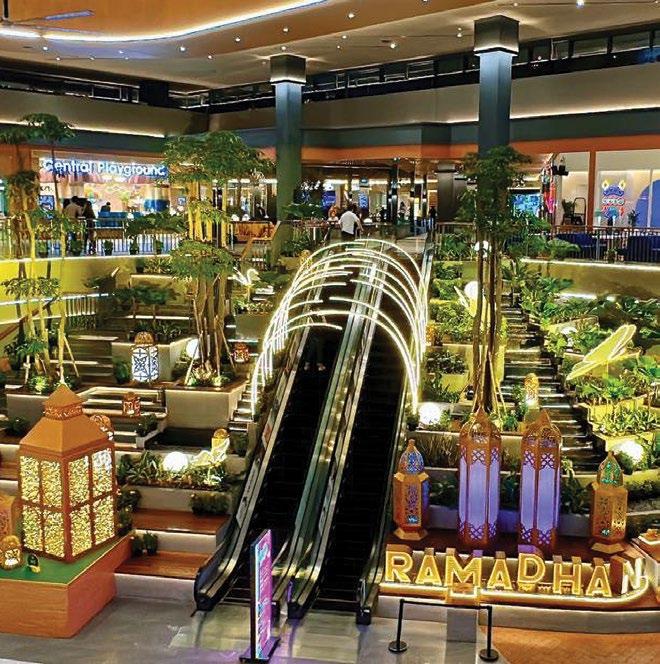

Sustainability is at the core of The Fullerton Ocean Park Hotel Hong Kong, earning it the WELL v2 Precertification— the first hotel in Hong Kong and Mainland China to achieve this accolade. Designed by Aedas, the resort features two towers that blend with the natural landscape, fostering a seamless indoor-outdoor connection. The hotel’s multilayered podium with terraces and lush landscaping descends toward the sea and caught the eye of the PropertyGuru Asia Property Awards judging panel, which awarded it Best Green Development (Hong Kong and Macau) in 2023.
Eco-friendly features include rainwater harvesting, energyefficient systems, and green spaces like vertical gardens and green roofs. The hotel offers 425 ocean-view rooms in 13 styles, all overlooking the South China Sea. Meanwhile, guest amenities include a 60-metre infinity pool, a luxury spa, a fitness gym, and dedicated areas for children.
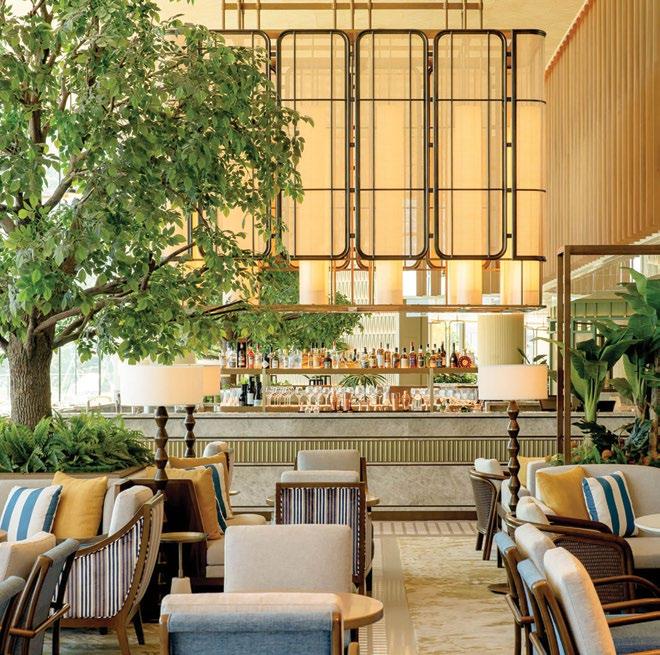

A housing crisis deepens in Australia where foreigners and locals are vying for lucrative property investments as well as roofs over their heads
BY AL GERARD DE LA CRUZ


Population growth, alongside a chronically undersupplied dwelling stock, has exacerbated a housing crunch in Australia.
Queues outside open home inspections went viral on social media as a once-in-a-lifetime demographic shift played out in the residential market.
Last year, the proportion of overseas-born residents in Australia exceeded 30% for the first time since 1893. At the same time, home values in the country-cum-continent
of almost 27 million soared by 8.1%, rebounding from a 4.9% drop in 2022, according to real estate data provider CoreLogic. Auctions in capital cities meanwhile recorded an annual clearance rate of 64.9%, up from 61.2% in the previous year.
This disconnect between supply and demand is “trumping the downside pressures from interest rates, high inflation, and low sentiment,” according to CoreLogic research director Tim Lawless. Having undergone 13 hikes since 2022, the country’s cash rate stood at 4.35%, a 12-year high.

The median home value underwent 16 consecutive months of growth to land at AUD785,556 (USD517,390) in May. That month, the number of listings in state capitals fell 16% below the previous five-year average.
Brisbane, where listings were 34% below the five-year average, is now the country’s second-most expensive state capital after Sydney, surpassing Canberra. In Perth and Adelaide, mid-sized cities with listings more than 40% below the average, home values rose annually by 22% and 14.4%, respectively.
Among other reforms to address the chronic housing shortage, Australia has mulled new policies encouraging the construction of more affordable, higher-density residential buildings.
In December, the New South Wales government began offering height and floor space ratio bonuses of 20% to 30% to developers who could allot at least 10% to 15% of their projects to affordable housing.
“Australia has been improving in terms of being on par with the building and living experiences in the rest of the world, where before Australia was very house-orientated,” says Peter Li, general manager of Sydneybased firm Plus Agency.
Demand for houses or detached dwellings has historically outpaced that for apartments, also known as units, according to the consultancy Savills Australia. House prices have risen by 166% over the past 20 years while unit prices have climbed by just 106%.
“People don’t understand living in highrises, which is still the case for a lot of cities out there,” says Li. “But now they’re shifting more into apartment living experiences, which means they’re getting more services than in the building they would typically have.”
Profitability for dwellings faces challenges regardless of density. Supply chain disruptions from the pandemic, as well as high construction costs, have raised new dwelling prices by about 40% since 2019, according to the Reserve Bank of Australia.
I genuinely believe Australia is now the top destination globally. We are not anywhere close to all the war areas. There are just loads of wealthy people looking at Australia as a safety net in this crazy world
After welcoming 494,000 people in 2023, Australia’s overseas-born population has grown to 8.2 million. In the first quarter of 2024, the share of foreign buyers in new housing markets hovered at 10%, a six-year high, according to the National Australia Bank (NAB).
The Great Australian Dream of home ownership is now shared by people born in India, China, Nepal, and the Philippines. These nations contributed the most to Australia’s population growth, in that order, between 2013 and 2023.
“Asian buyers are a driving force for a lot of demand of homes still,” says Peter Li, general manager of Sydney-based real estate firm Plus Agency. “In Asian buyers’ minds, they don’t just want to rent—they want to own the home.”
Around 5,200 millionaires relocated to Australia in 2023, compared to just 2,100 for the US, according to migration consultancy Henley & Partners.
“I genuinely believe Australia is now the top destination globally,” says Benson Zhou, state head for Asia markets and director at the consultancy Savills Australia. “We are not anywhere close to all the war areas, given what’s happening in this crazy world. There are just loads of wealthy people looking at Australia as a safety net.”
For most of 2023, China was the leading source of approved residential property investments, injecting AUD1.1 billion into the country in the second quarter alone, according to the Foreign Investment Review Board (FIRB).
Li, however, predicts Chinese interest to decline by 2025 due to China’s weakened economy. Affluent Chinese buyers, already burdened with capital controls, also reckon with this year’s elimination of the Significant Investor Visa (SIV), a long-favoured route to Australian residency.
“On the other hand, we see increasing demand from Southeast Asia,” says Li. “Overall foreign buyer demand will remain similar, but the source countries will change.”
Vietnam, Indonesia, and Singapore ranked among Australia’s top 10 sources of approved residential investments last year.
While prices skyrocketed, the volume of transactions lagged, suggesting the dominance of post-pandemic upgraders and financially capable buyers in the market. The Housing Industry Association noted a 34% annual decline in nationwide transactions up to October while digital platform PEXA recorded an 18.6% drop in property settlements in 2023.
“The prices went high because people are swapping homes,” says Li, whose agency completed more than AUD305 million in transactions last year. “They are the people who don’t get affected by the interest rate that much because they’re very cash-strong or asset-strong.”
This cohort is likely able to absorb the increased fees, surcharges, duties, and taxes levied on foreign nationals in 2024. Since April, foreign investment fees for the purchase of existing homes have tripled, turning non-residents towards new developments.
APARTMENT PRICES IN MELBOURNE HAVE FALLEN OVER THE LAST FIVE YEARS, REVEALING THE EFFECTS OF A DECLINE IN INVESTOR ACTIVITY

From investors to international students, foreigners hoping to live, study, and work in Australia are facing a wall of barriers in the guise of stricter visa policies.
Earlier this year, Australia quietly scrapped the Business Innovation and Investment Program, which had issued Significant Investor Visas (SIV) to high-net-worth individuals abroad since 2012.
According to government data, the Chinese constituted 85% of successful applicants for SIV, nicknamed “888 visas” after a symbol of luck in China. These golden visas presented a dependable pathway to residency by investment.
International education, another tried-and-tested route to migration, has also come under visatightening terms. Starting in May, student visa applicants must demonstrate a larger financial capacity for their studies.
Nevertheless, Australia still recognises the need to cover labour shortfalls even as it aims to cut down on migration. In 2024, Australia is easing requirements for the Temporary Skill Shortage Visa and introducing the new National Innovation Visa, which appeals to talented migrants.
The country is also offering two-year visas to Indian graduates and professionals through the Mobility Arrangement for Talented Early-Professionals Scheme (MATES). Applicants from India, China, and Vietnam are also eligible for Work and Holiday visas through a ballot process.
Australia currently requires 90,000 people, in addition to its existing construction workforce, to meet National Housing Accord targets.
IN THE FIRST QUARTER OF 2024, THE SHARE OF FOREIGN BUYERS IN NEW HOUSING MARKETS IN AUSTRALIA HOVERED AT 10%, A SIX-YEAR HIGH
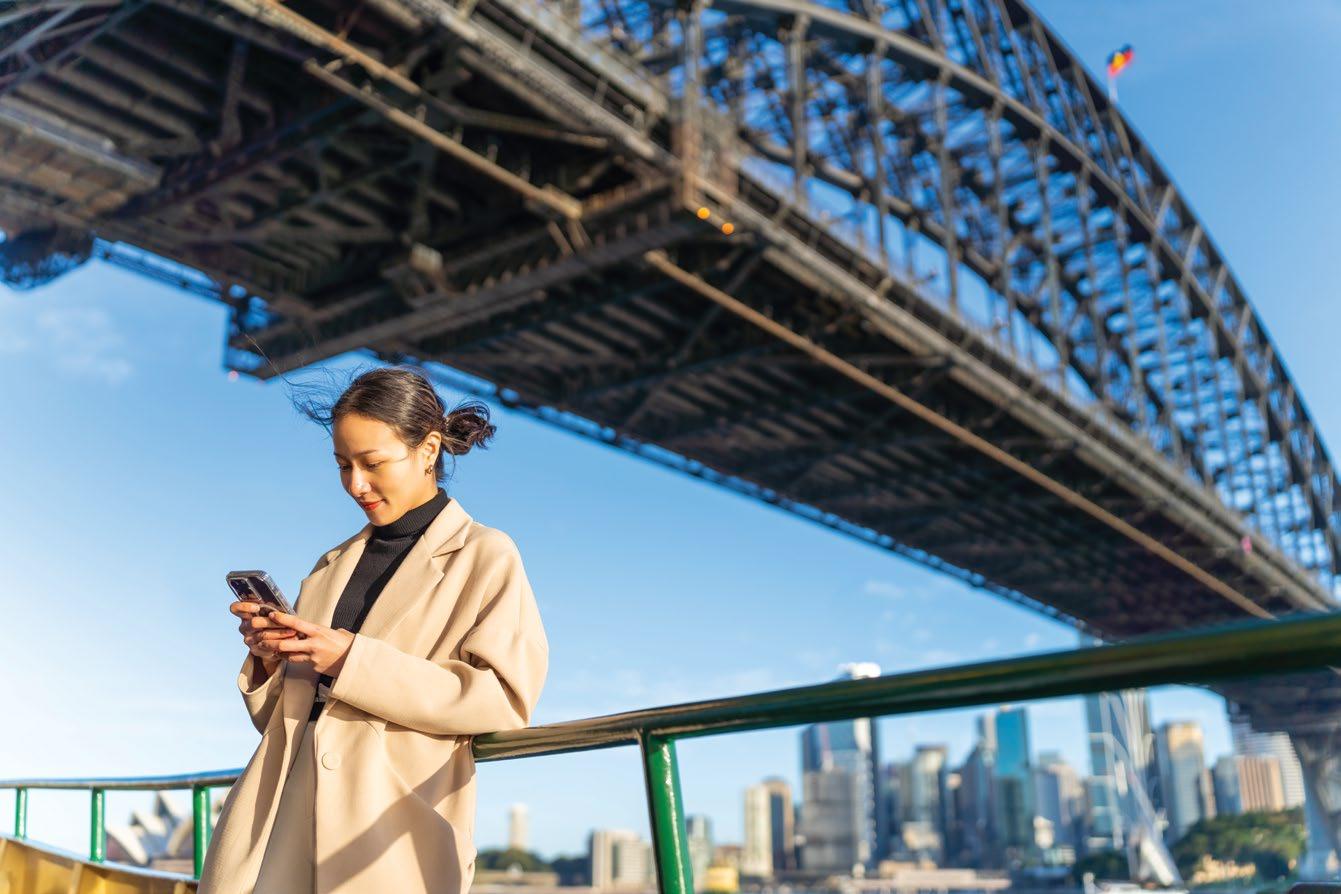
“In the long run, Australia will be the safest hub for a lot of money to be parked in,” says Li. “But if you’re expecting that you can double your money in two years, maybe Australia is not your best choice because the prices are already so high...I don’t think you’re going to make as much capital gain, compared to selected countries, as when it was on a bull run.”
Housing stress disproportionately affects first-time homebuyers and low-income migrants. A recent report by CoreLogic and ANZ bank revealed that the proportion of income needed to cover median rents hit a record high of 32.2% in March while servicing a new mortgage reached a peak of 48.9%.
The Albanese government seeks to temper demand by halving net migration intake from 528,000 in 2023 to 260,000 by 2025. Also, starting in 2024, the government is building 1.2 million homes over the next five years under the National Housing Accord.
With developers delaying or foregoing projects altogether, dwelling approvals last year sat at around 162,200, a decade low, according to NAB.
Redistributing existing stock, instead of building anew, could remedy the supply-demand mismatch. Increasing the average household size, which has dwindled to 2.5 individuals since the 1980s, to 2.8 individuals would house the populace in 1.2 million fewer dwellings, according to Reserve Bank of Australia chief economist Sarah Hunter.
But as birth rates fall, Australia simply cannot halt migration, with population growth “the only thing standing between Australia and recession,” according to Callam Pickering, an economist at job site Indeed. Australia narrowly avoided one in Q1 2024 as the economy posted its slowest quarterly growth since 2021.
Peopling Australia, with its multicultural mystique intact, would ostensibly require little effort. The Australian government has sailed through various socioeconomic headwinds in the past via a competent migration policy.
“If something didn’t work, they just keep the migrants’ tap up,” says Zhou. “The smart thing about the government is they know there’ll be millions of people wanting to get an Australian visa.”

The Foreign Investment Review Board (FIRB) bars non-nationals from buying existing residential property in Australia except in special cases.
Many obstacles face foreigners when they are allowed to do so. In April, the board tripled the nonrefundable application fee for acquiring established dwellings, starting at AUD42,300 for those valued at AUD1 million.
Application fees for new builds, which can be sold to non-nationals, currently start at AUD14,100 for a million-dollar dwelling.
Under this year’s Foreign Investment Bill, the federal government now allows states to impose a stamp duty surcharge on non-nationals even if such payment is not aligned with Australia’s double tax agreements. The additional levies, paid on top of transfer duties, hover at 8% in New South Wales and Victoria.
“Anyone who isn’t highly motivated can be deterred by the fees,” says Peter Li, general manager of Sydney real estate firm Plus Agency.
Vacancy fees have also been doubled on all foreignowned dwellings bought since May 2017. In Victoria, the absentee land tax surcharge, imposed on foreign buyers on top of their general land tax, vaulted from 2% in 2023 to 4% in 2024.
“Holding costs will be a lot higher than what a local developer is holding,” says Benson Zhou, director at the consultancy Savills Australia. “The new land tax is going to bring the market down.”

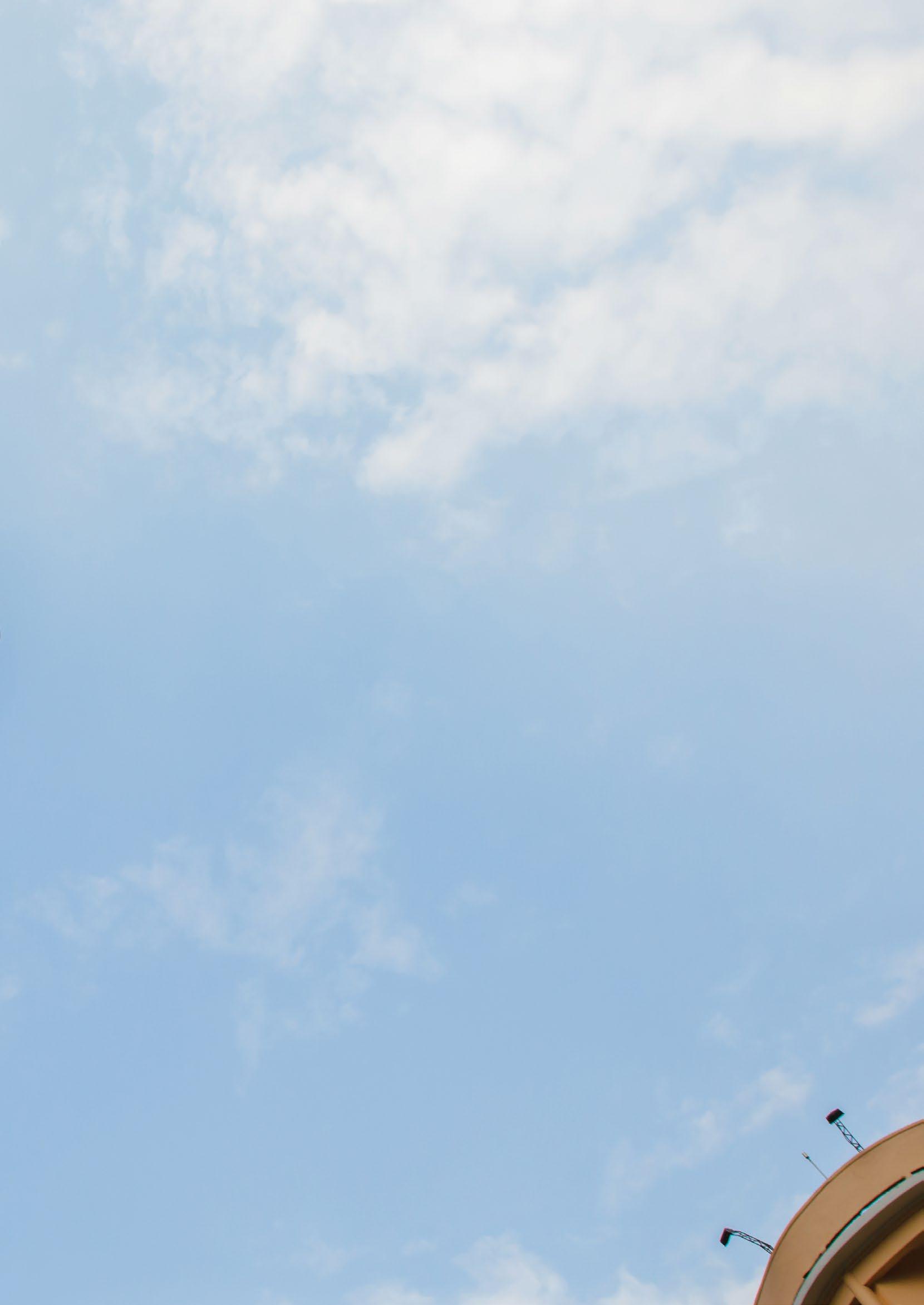
Vietnam’s property scene has experienced its most traumatic period with corruption scandals sending the market into freefall. But experts are predicting light at the end of the tunnel.
BY GEORGE STYLLIS
THE REAL ESTATE MARKET IN HO CHI MINH CITY AND NEIGHBOURING LOCALITIES HAS SEEN POSITIVE PERFORMANCE IN THE EARLY PART OF 2024


Inside an old yellow courthouse in Vietnam last month, a trial like no other was playing out. The room was heavy with drama as defendants, lawyers, guards, and other officials jostled for space on the benches and aisles and bore witness to history.
At the centre of it was a 67-year-old property tycoon, Truong My Lan, who had been accused of perpetrating the biggest fraud in the country’s history. When the verdict came in, she was found guilty of fraud to the tune of USD12.5 billion and sentenced to death.
Truong was the biggest fish caught in an 11-year anti-corruption campaign called Blazing Furnace. Others included hundreds of officials, cabinet ministers, presidents, and two deputy prime ministers.
The arrests and convictions sent the intended message to the public that corruption will not be tolerated. But while that might be good for politics, it’s been less helpful for business, sending chills through the property market especially.
Vietnam’s problems with the property market began before the pandemic when developers began expanding aggressively, using local banks and bond markets to drive growth.
The sector began to draw concerns as developers with a stock market overlap created a risk of contagion. Questions were also being raised over whether lenders were overleveraged and at risk of going bust in the event of a downturn.
When Truong was arrested last year, the extent to which the property sector was fuelling the economy was laid bare as a run was triggered on the Saigon Commercial Bank, prompting the central bank to step in.
Investors couldn’t sell their bonds fast enough and hundreds of small developers were imperilled along with thousands of projects. Buyer demand plummeted as people pondered whether the house they wanted would be built as promised.
DANANG HAS BEEN HIT BY A DECLINE IN DEMAND FOR PROPERTY, ESPECIALLY LANDED UNITS

Thien Duong, general director of the architect company GSA Studio, says he has seen enquiries and sales drop drastically.
“Buyers, sellers, and developers are holding back, affecting property transactions and development projects,” Thien says.
In August last year, Vietinbank auctioned off more than 350 properties with a total value of USD337 million “because their borrowers could not pay for their debt,” says Ken Duong, CEO of Duong Global Business Consulting. Sacombank and BIDV bank were doing a similar thing, he adds.
“House prices dropped in all sectors of the market,” he says, prompting many brokerages to close especially in Ho Chi Minh City—where apartments saw an average drop of USD38,100—and Hanoi.
Business sentiment dented by the arrests in the anticorruption was one of the main reasons for the lower growth along with nervous bureaucrats taking a cautious approach to giving permits to any big business projects.
Some of the biggest companies hit by the crisis witnessed their shares hit the floor with drops of up to 80%.
A turnaround in the real estate sector is anticipated later this year and next, bolstering domestic demand as investors and consumers regain confidence

Along Kim Ma Road in downtown Hanoi, shops stand shuttered; “for sale” signs hang outside. A similar picture blights parts of Ho Chi Minh City.
Vietnam has been the darling of Southeast Asia’s e-commerce market with one of the fastest-growing logistics sectors in the world.
Between 2018 and 2022, revenue from retail e-commerce surged from USD8 billion to USD16.4 billion and drew investments from big names including Alibaba and Amazon.
However, it has put a strain on brick-and-mortar shops, forcing many to close.
In recent months, several dozen shops in Hanoi’s Hoan Kiem and Dong Da districts have closed due to a lack of tenants.
On Kim Ma Road, where most of the small fashion shops and restaurants are located, the picture is starkest.
Property broker Minh Thu told VN Express that high prices are dissuading many would-be tenants.
“Prime locations in Hanoi with rents of VND15-20 million per month used to be filled with tenants, but now many of them are vacant, even if landlords offer incentives such as reduction in deposit.”
Yet not all shops are in trouble. For malls and other big retail complexes, the outlook is brighter.
One of those doubling down on the market is Japanese company Aeon, which has started building its eighth mall in Vietnam, in Long An province, which is due to open in late 2025.
Analysts predict malls will maintain their growth and strong occupancy rates, but much of that will depend on their ability to offer people more than just a place to shop.
“Local customers are not only looking for shopping destinations but also for complete experiences with entertainment and dining,” says Hoang Nguyet Minh, senior director of commercial leasing at Savills Hanoi.
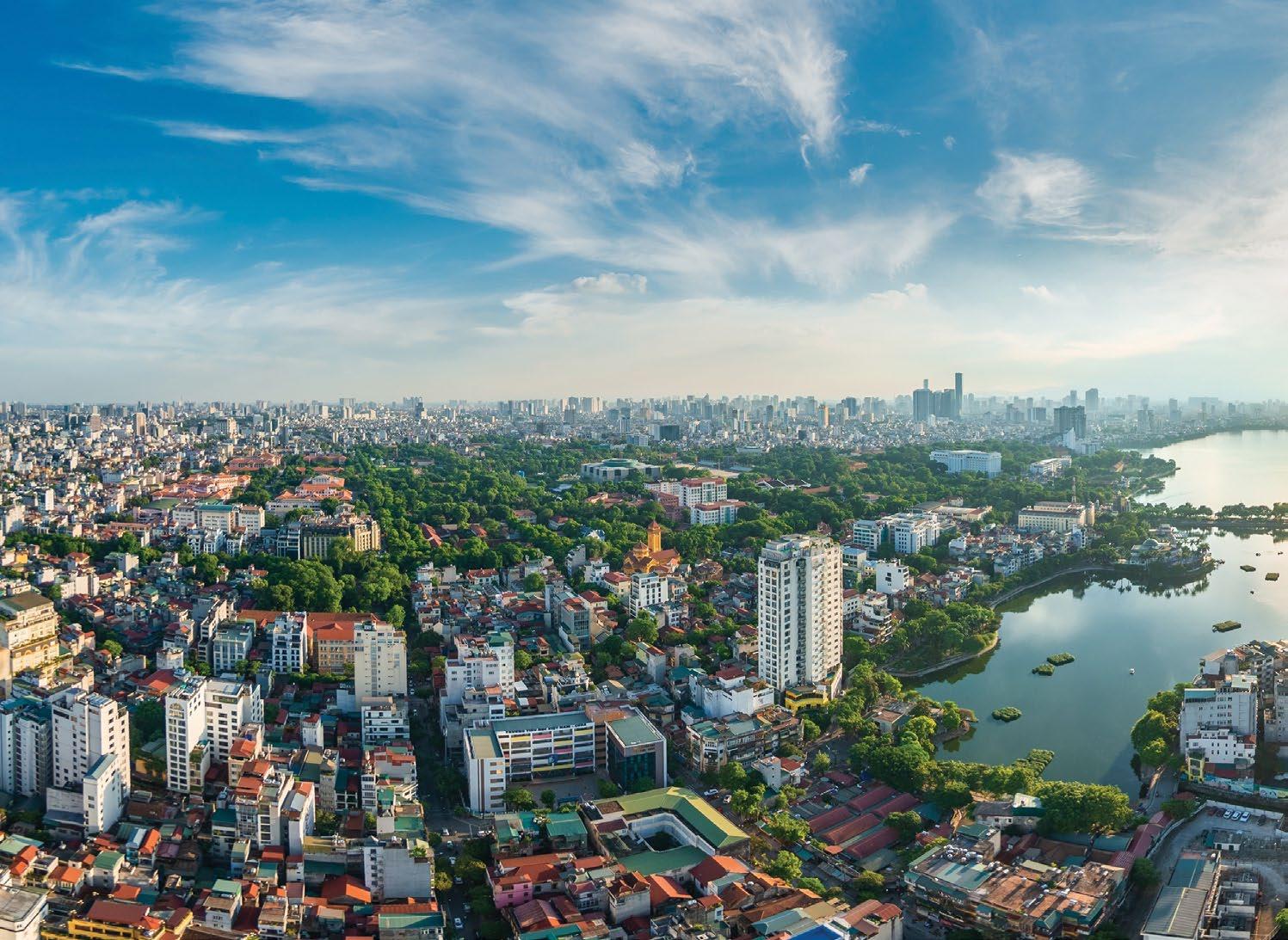
The result was a landscape of empty buildings, shrouds of green netting, and abandoned building sites.
As a result, the country has missed its growth targets. Last year, it reached 5.05%, below the government target of 6.5%. In 2022, it was 8.02%.
This year, however, a slightly stronger economy offers some hope the property market could soon get better.
The World Bank said in an April report that it was seeing a recovery in exports and consumption while a “turnaround in the real estate sector is anticipated later this year and next, bolstering domestic demand as investors and consumers regain confidence.”
Among the reasons it cites is that “the bond market freeze appears to have eased.” That follows attempts by the government to reinvigorate the corporate bond market by granting a two-year extension in bond maturities, conditional on shareholder approval.
The World Bank added: “With the gradual recoveries of exports and the real estate market, domestic demand is set to firm up as investors and consumers regain confidence.”
The bank predicts the economy will grow to 5.5% in 2024 and 6% in 2025.
Thien still believes there’s reluctance among officials to grant permits but those with land already are in a strong position. He believes the next couple of years will see the market readjust with only the “cream of the crop” able to survive.
Some of those he points to that are faring well are developers like Masterise Homes, which is developing an eight-hectare project with more than 200 townhouses in Thuy Nguyen District, Hai Phong City. Also promising are projects like The Ritz Carlton Residences in Hanoi, and Tokyu Garden City, a township development in Binh Duong City, about an hour’s drive from HCMC. A SLIGHTLY STRONGER ECONOMY OFFERS SOME HOPE THE PROPERTY MARKET
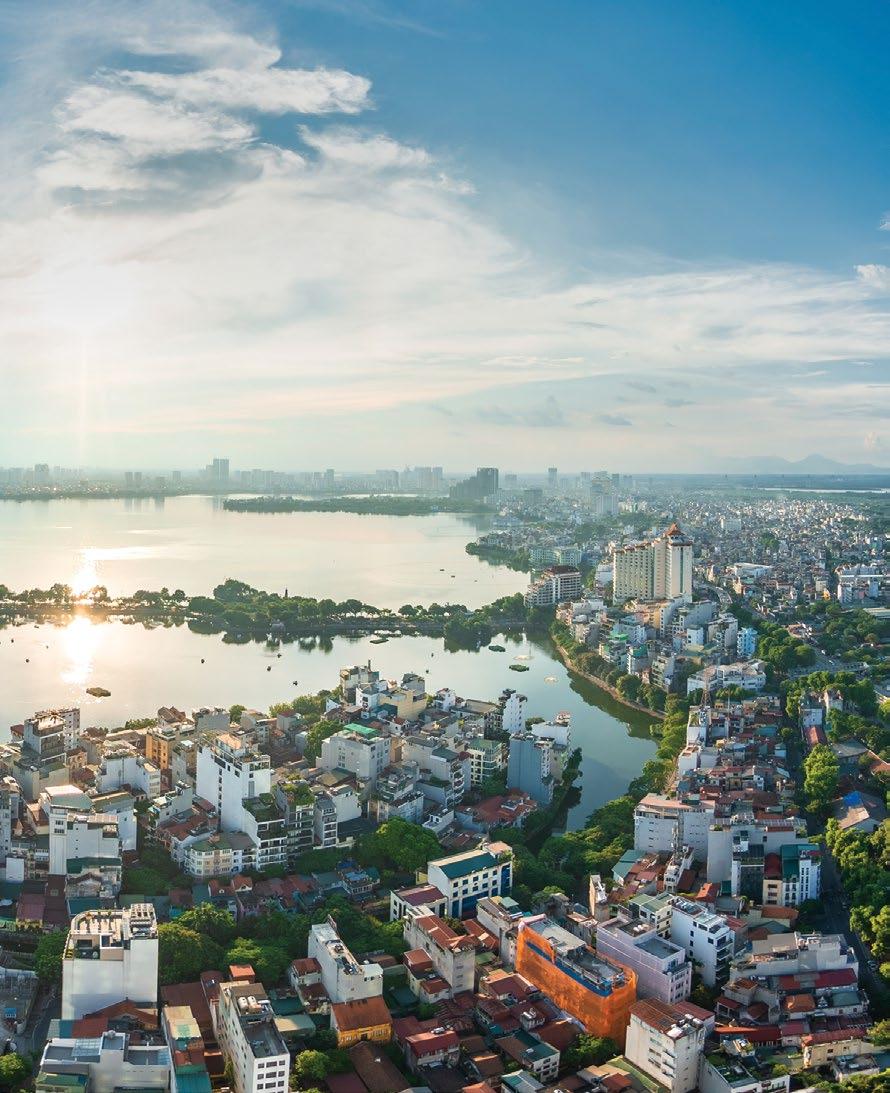
Other projects that analysts are looking out for are Lumiere Evergreen and The Sola Park in Hanoi, Golden Crown in Hai Phong, and Hal Long Marina in Quang Ninh province.
Hang Dang, managing director of CBRE Vietnam, says the condominium sector is showing the most signs of promise at the moment, especially in Hanoi, after the boom in landed property in 2021 and 2022.
“Active sales and booking activities for condominium projects in Hanoi have been observed since the end of Q1 2024. By the end of Q2 2024, we expect the total new supply within the first half of 2024 to reach around 8,000 units in Hanoi, almost double the level recorded in H1 2023.”
The total number of new condominium launches in Hanoi is expected to reach around 14,000 to 15,000 units in 2024, while that of HCMC is expected to reach around 8,000 units.
Experts know that after the turmoil the industry has experienced recovery will not be swift or sudden. But there is reason to hope that the worst of it might be over.
Nobu has doubled down in Vietnam with the announcement of the launch of its second hotel in the nation, as urban hotels outperform those by the beach.
The luxury lifestyle brand said its new Nobu Hotel and Restaurant will open in Ho Chi Minh City in 2026.
The 40-storey complex is a collaboration with Viet Capital Real Estate and follows the announcement of its inaugural hotel in Asia, in Danang, due to open in the same year.
“We are thrilled to announce our second property in Vietnam and are eager to deepen our partnership with VCRE as we introduce Nobu Hotel and Restaurant Ho Chi Minh City,” says Trevor Horwell, CEO of Nobu Hospitality.
Nobu’s announcement comes amid a strong performance by hotels in urban centres in contrast to those in tourist hotspots.
Pre-pandemic, Vietnam drew 18 million international visitors. Last year that number was down to 12.6 million as recovery proceeded more slowly than expected.
Ben Gray of property consultancy Knight Frank says developers should stop building new beachfront hotels, especially in Phu Quoc and Ha Long Bay, due to the risk of oversupply and having 20 million luxury hotel rooms vacant each year.
Gray, who is the director of capital markets at the consultancy, says “These locations have seen rampant hotel project development that exceeds demand.”
Among other well-known brands which have also launched recently in cities are the Sheraton Hanoi West and the Hilton Saigon.
“Vietnam is charting dynamic growth and fast establishing itself as a leading travel destination in Asia,” says Alan Watts, president for Asia Pacific at Hilton.
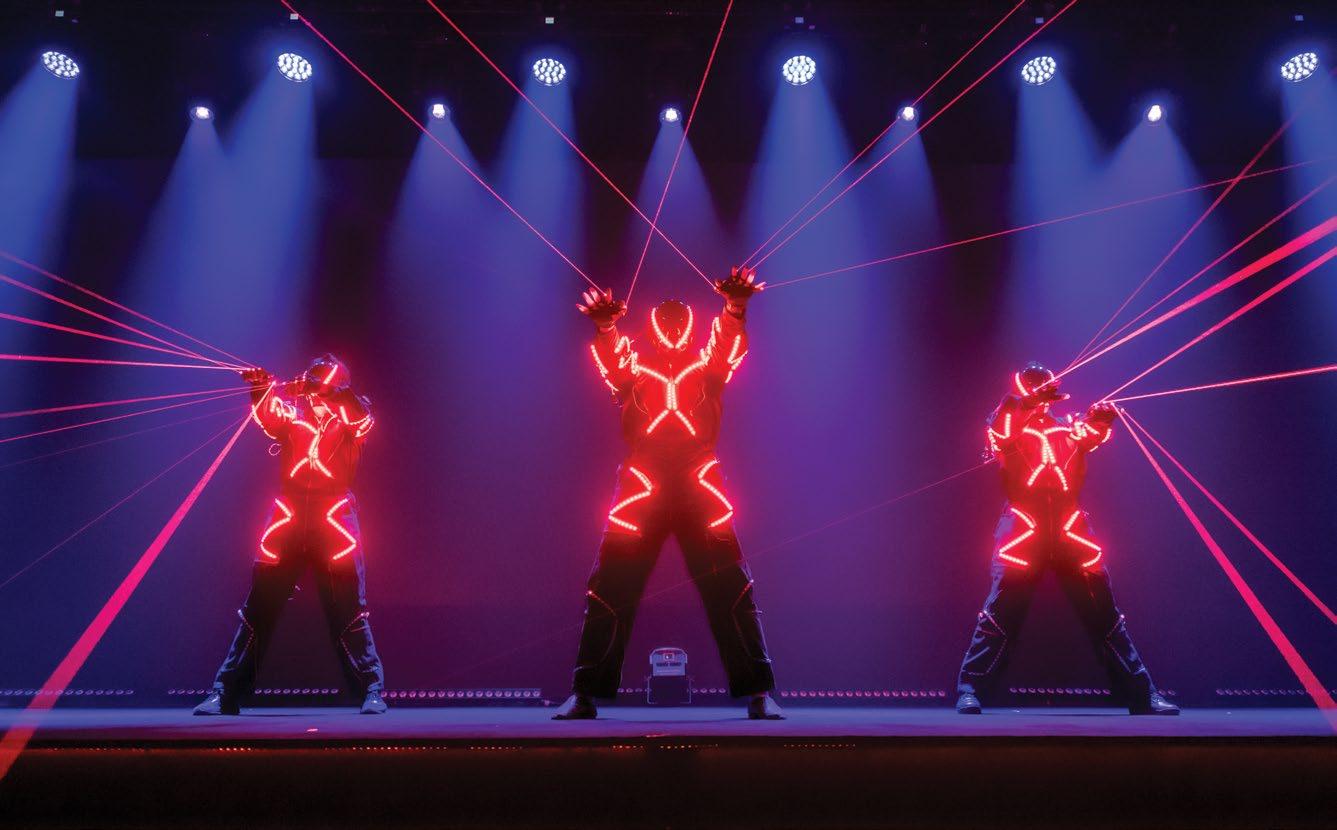
The 2023 PropertyGuru Asia Property Awards series built up to four days of engaging, high-level activities in December, also known as PropertyGuru Week.
As the highlight of the region’s real estate calendar, PropertyGuru Week featured collaborative and glamorous events that brought developers, innovators, decisionmakers, and public figures from around the world to Bangkok.
PropertyGuru Week began on 6 December 2023 with a roundtable discussion and networking dinner for industry leaders. The event was organised by PropertyGuru for Business, the complete real estate and property software solution for companies looking to maximise results in the real estate space.
The following day, global thought leaders and top minds at the intersection of property and technology gathered at The Athenee Hotel, a Luxury Collection Hotel, Bangkok, for the ninth edition of the PropertyGuru Asia Real Estate Summit (ARES). The 2023 edition of ARES drew more than 400 international delegates for an insightful hybrid conference and networking event centred on “Powering Communities”. Nearly 40 diverse, inspiring speakers engaged in thoughtprovoking discussions on the future of communities, business, leisure, and innovation.
Immediately following the summit, an exclusive VIP party celebrated six “Power Women” from around the world for their extraordinary leadership and achievements that broke the glass ceiling in their respective fields.

PROPERTYGURU GROUP CEO HARI V KRISHNAN
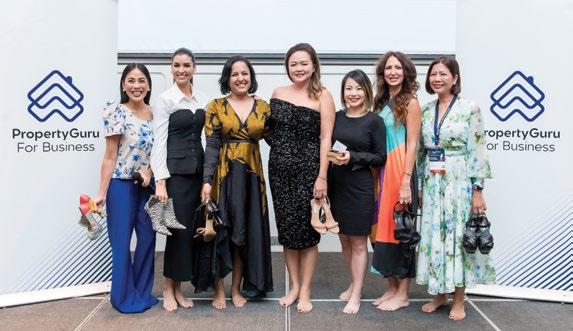
ARES POWER WOMEN 2024

PROPERTYGURU FOR BUSINESS ROUNDTABLE

ARES VIP PARTY

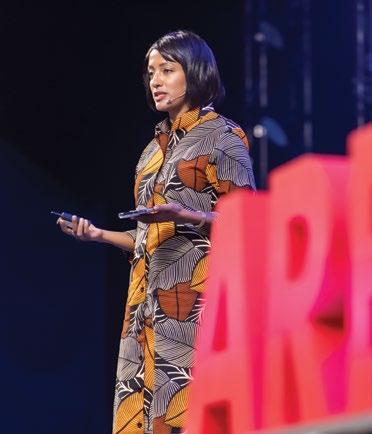

WALLMAKERS’ VINU DANIEL WITH PROPERTYGURU’S JULES KAY
EICN’S SUMANA RAJARETHNAMKRISHNAN


PROPERTYGURU DATA AND SOFTWARE SOLUTIONS’ SHYN YEE HO-STRANGAS

PropertyGuru Week continued 8 December with the PropertyGuru Asia Property Awards International Luncheon, celebrating the finest real estate in Mainland China, Hong Kong, Macau, India, and Greater Niseko in Japan.
Also held at The Athenee Hotel, a Luxury Collection Hotel, Bangkok, the luncheon saw top developers such as Apex Property, CSI Properties Limited, DLF Cyber City Developers Ltd., New World China, and Sino Land Company Limited claim coveted Developer titles in their respective property markets.
That evening, esteemed winners of the PropertyGuru Asia Property Awards series, representing 13 dynamic markets across the Asia-Pacific region, gathered at the hotel for the
gala dinner of the 18th PropertyGuru Asia Property Awards Grand Final. The highly anticipated presentation ceremony featured appearances by real estate icons such as Dr. Allan Zeman and a performance by Thai singer Wan Wanwan, elevating the night to new heights. The event concluded with Singapore developer GuocoLand receiving its third win as Best Developer (Asia).
Over 50 golden statuettes were awarded to developers and projects deemed the “Best in Asia”.
To cap off PropertyGuru Week, the ARES team hosted a private screening of “Wonderful Waste”, an acclaimed series by Australian media company NeverTooSmall, on 9 December at Cinema Oasis in Bangkok.


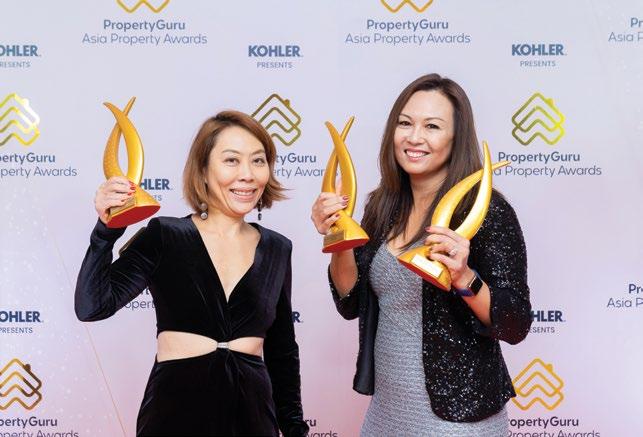
APEX PROPERTY’S





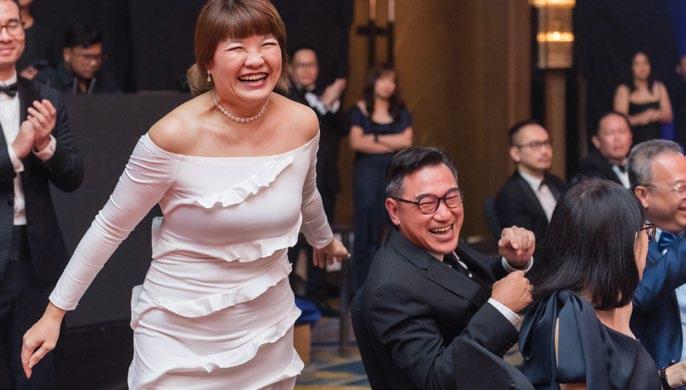

Thailand’s persistent problems with polluted air—especially bad in the northern city of Chiang Mai—are prompting calls for tougher government action and a shift in developer practices to mitigate the crisis
By Liam Aran Barnes
Chiang Mai is one of the undisputed jewels in Thailand’s tourism crown. On the doorstep of some of the country’s most stunning nature, the idyllic northern city beckons visitors with its laidback blend of ancient temples, legendary Lanna cuisine, and lively arts and music scene.
But then March rolls around, and the smog rolls in. Every year, for about two months, Chiang Mai is shrouded in pollution, driving tourists away while long-suffering
residents endure the poor living conditions. This pollution is exacerbated by the city’s location in a valley, which traps the smoke from agricultural burning in the region.
The city recorded the world’s worst air quality for several consecutive days this year. Levels of PM2.5 pollutants—fine particles small enough to enter the bloodstream through the lungs—frequently surpassed 220, 20 times higher than World Health Organisation guidelines.
The Thai capital Bangkok also suffered from severe pollution in February and March, prompting Prime Minister Srettha Thavisin to issue stay-at-home warnings to government staff and the wider public.
“These figures—PM2.5 and PM10—sound innocuous but most people don’t realise that these are minuscule particles that are impossible not to inhale,” built environment expert John Herbert told The Telegraph in April. “If you’re exposed to these levels longterm, or even for a few months, you’re going to face serious respiratory disorders and possible hospitalisation.”
Indeed, recent data released by Thailand’s Health Ministry revealed that an estimated 10.5 million people in the country suffered from diseases related to air pollution in 2023.
And yet, this is by no means a recent phenomenon. It is almost as if a collective amnesia takes hold of officials for another nine or so months. Despite strong statements on tackling the pollution, Srettha declined to designate Chiang Mai as a disaster area to protect the country’s tourism sector. In an online announcement, he said the designation would “affect the number of foreign tourists when tourism has just recovered in the wake of COVID-19.”
The recurring pollution crisis doesn’t only affect public health and tourism; it also casts a long shadow over real estate markets. While there’s no clear correlation between the direct impact of air pollution on Bangkok and Chiang Mai’s real estate markets, there is growing caution among investors, who are increasingly looking at less polluted areas such as Mae Hong Son, Phayao, and Chiang Rai for development, according to real estate
analyst Marciano Birjmohun.
“Buyers are starting to consider the longterm negative effects of air pollution, especially concerning their families’ health,” he says. “Although government policies have so far been ineffective in significantly mitigating pollution, developers are responding by incorporating green features and sustainable practices in their projects.”
Innovations such as air filtration systems, smart building technologies for real-time air quality monitoring, and biophilic design principles are becoming more prevalent. These efforts aim to address the immediate impact of poor air quality and enhance the overall attractiveness and healthfulness of urban living environments. Still, Birjmohun notes that “the lack of strong regulations to address the root causes, like industrial emissions and agricultural burning, remains a cause for concern.”
Another significant issue is the lack of sustainability data. Unlike North America and Europe where sustainability is closely managed by governments, in Asia, there is little understanding of key metrics outside of Singapore and a few other gateway markets. This gap makes it challenging to address investor sentiment and promote environmental compliance.
“Typically, in the West, listed groups have compliance initiatives, and large private equity groups investing in larger projects have environmental mandates,” says Bill Barnett, founder and managing director of Asia-based consultancy C9 Hotelworks. “This is not the case for most of Thailand’s real estate developers, though there are some notable exceptions like the Minor Group. It’s a work in progress, but the
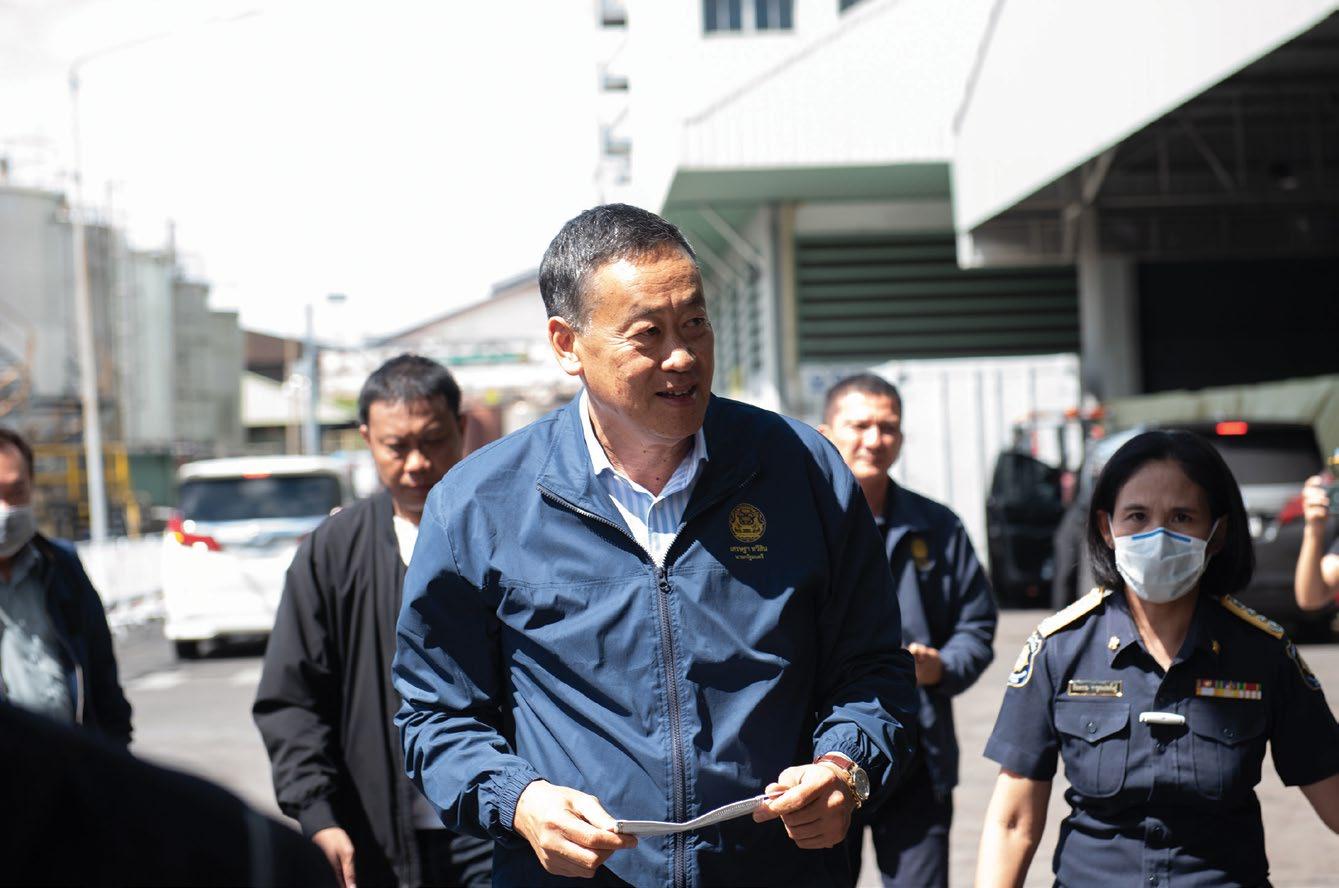
problem is a clear and present danger to urban residential health and tourism alike.”
The economic cost of pollution to Thailand is substantial, encompassing health-associated risks and impacts on insurers. These costs represent a significant, often overlooked issue. Additionally, attracting international investors, particularly from the West, who require high levels of compliance and a robust regulatory environment, poses a further challenge. Ignoring the growing pollution problem risks lagging economic growth and deterring potential investors.
Addressing these issues requires both government intervention and a shift in developer practices. Barnett advocates for making an economic case for sustainability by highlighting energy savings, procuring local materials for carbon credits, and educating developers on how sustainability can enhance asset value versus the misconception that it’s costlier.
DESPITE STRONG STATEMENTS ON TACKLING THE POLLUTION, THAI PM SRETTHA THAVISIN DECLINED TO DESIGNATE CHIANG MAI AS A DISASTER AREA TO PROTECT THE COUNTRY’S TOURISM SECTOR
“Challenges can become more prevailing, and they have to come with innovation and sustainability frameworks to improve the air quality in and around their developments,” he adds. “Forward-looking developers do not maximise their gross floor area anymore but rather offer a higher ratio of green area to commit to a healthier path of sustainability.
“On the construction and engineering side, more buildings invest in air filtration systems on a macro level, and additionally offer custom air quality devices in individual units.”
As the annual haze continues to consume Chiang Mai and Bangkok, it’s clear that bold measures are needed. The inaction of the past must give way to collaborative efforts between the government and private sector, driven by the increasing demand for wellness in investments. This can help turn the tide, ensuring these cities are once again vibrant and healthy places to live and invest in.

The global EV boom is fuelling industrial real estate sectors around Southeast Asia, but there’s been negligible impact so far on the region’s residential markets
By Steve Finch
Thailand’s potential as a hub for electric vehicle (EV) production got a huge boost when Elon Musk met Thai Prime Minister Srettha Thavisin in New York last year.
It emerged that Thailand had been shortlisted as a possible site for a new Tesla factory. Follow-up meetings with Tesla executives were later held in Bangkok. As yet, though, a Tesla Thailand factory has not materialised.
THAILAND WAS SHORTLISTED AS A POSSIBLE SITE FOR A NEW TESLA FACTORY, BUT AS YET NOTHING HAS TRANSPIRED
Tesla told the Thai government a huge 320-hectare site would be required, larger than most industrial estates in the country.
“City planning doesn’t support that,” the Thai government said.
Meanwhile, BYD, the Shenzhen-based EV giant, went ahead with construction on a new Thailand factory in March at a much smaller 96-hectare site. Already the number-one EV seller in Thailand, BYD plans to roll out 150,000 units per year from the new facility
ASEAN HAS BECOME A KEY BATTLEGROUND IN THE GLOBAL EV INDUSTRY. AND FAST-MOVING CHINESE COMPANIES ARE THE CLEAR WINNERS AT THIS STAGE
following the start of trial production this year.
With Singapore set to cease all new combustion engine vehicle sales by 2030, and Thailand, Vietnam, and Indonesia moving towards similar deadlines in 2035, 2040, and 2050, respectively, ASEAN has become a key battleground in the global EV industry. Thus far, fast-moving Chinese companies are the clear winners, driving changes in real estate dynamics across the region.
In Thailand, the top two brands by sales in 2023—BYD and Neta—were Chinese, the former outselling Tesla, which placed fourth, more than three times over, according to official data.
By the end of last year, Thailand’s Board of Investment (BOI) had approved at least 26 EV-related projects, according to an analysis by law firm Baker-McKenzie. In April, Chery announced plans for a new factory in Rayong, becoming the eighth Chinese EV company to set up in Thailand.
“The BOI is committed to the government’s policy of making Thailand a manufacturing hub of EVS in the region,” said BOI SecretaryGeneral Narit Therdsteerasukdi following Geely’s announcement.
Indonesia is also establishing itself as a regional EV hub. Last year, multinational real estate agency Colliers said the EV sector would take “centre stage” as the country’s industrial real estate industry looks to emerge as a key ASEAN destination for global high-tech investment.
BYD announced plans for a new 100-hectare
factory in Subang, West Java in May, with construction due to start this year, and operations scheduled for early 2026, according to a company announcement. Of BYD’s five overseas production bases, two— Thailand and Indonesia—will be in ASEAN.
A key regional market for BYD and other Chinese EV makers, Singapore is set to be the first country in the region to ban combustion engine sales with a target date of 2030. Complications remain, however. Critics of Singapore’s ambitious EV plans have lamented the slow roll-out of charging points in public spaces and commercial buildings, so too the still high cost of EVs in the city-state.
“There seems to be this feeling building up that the EV dateline could be extended,” says Alan Cheong, executive director of research and consultancy at Savills Singapore. “Already, there are questions about the viability of mass-scale adoption of EVs in developed countries. So long as there are nagging questions and alternative methods to powering vehicles, it would sow doubts whether it is wise to follow that 2030 timeline.”
Although EV unit sales in Singapore surged more than 50%, according to Land Transport Authority data, the base remains low with just 18% of new vehicle registrations in the EV class. Price remains a key issue. Last year, the most affordable EV on the market in Singapore was BYD’s Dolphin priced at SGD159,888 (USD118,400), although other low-cost Chinese car-makers Zeekr and Xpeng were due to begin EV sales later this year.
These uncertainties have played into
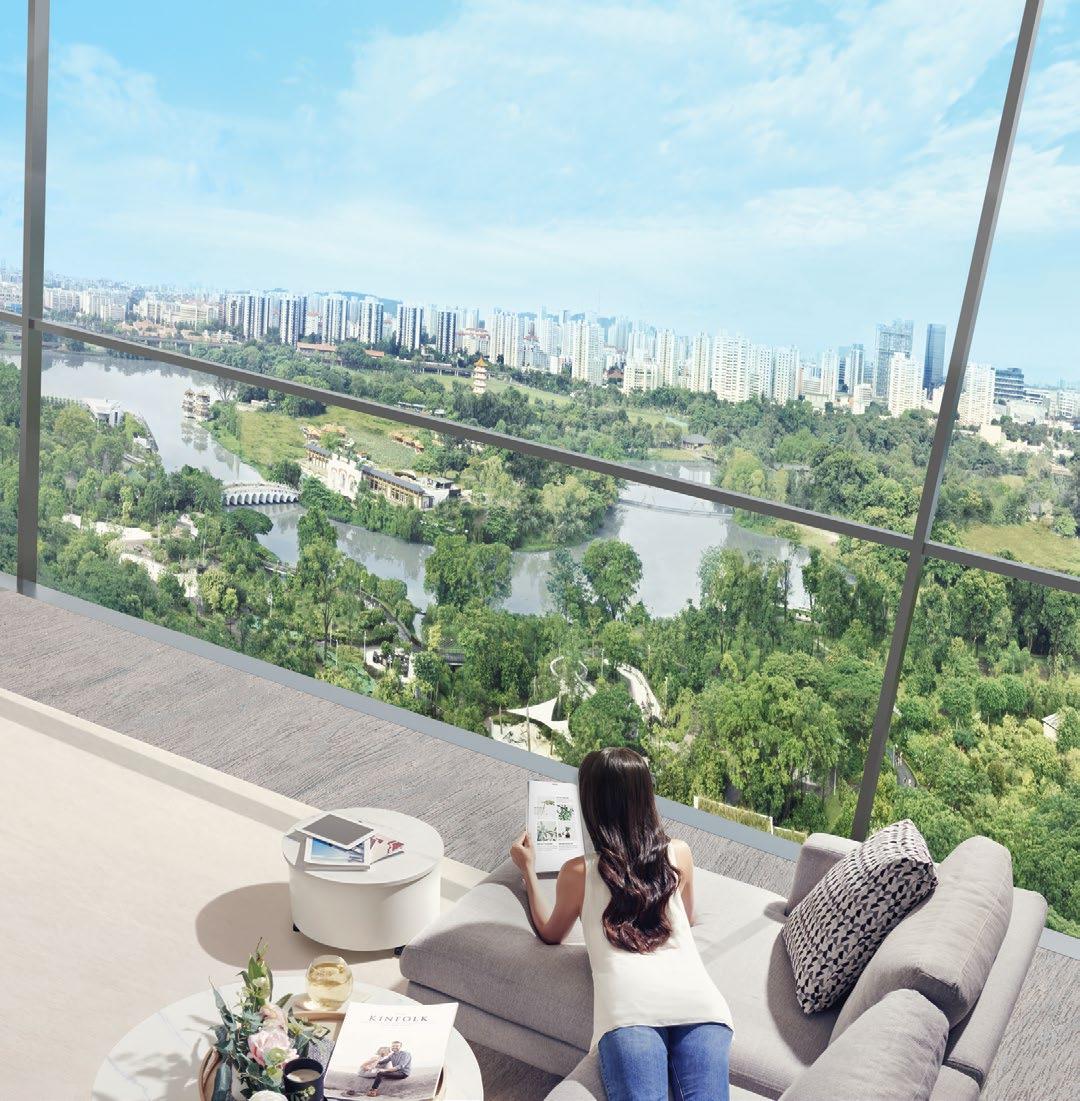
A home with unmatched views of the lake and garden, and just a stone’s throw away from Jurong Lake District. Live right at the heart of a world-class hub of edutainment, business, leisure and technology. With a curated selection of 1-to-5-bedroom units, 4 exceptional penthouses and lush greenery, these residences are designed with sustainability and nature in mind. A home for now and future generations to come. The LakeGarden Residences – waterfront living at its best.




residential market considerations when it comes to EV adoption and installing power points for vehicles, according to Cheong of Savills. Still, few buyers are demanding EV charging points, he says. “There has been some uptick in inquiries but it is not moving the needle,” he says. “Whether for investors or owner-occupiers, they don’t specifically ask about EV infrastructure.”
In Vietnam, another fast-emerging EV sales and production market in the region, charging points have recently become a sales negative. In September last year, a fire at an apartment building in Hanoi led to the deaths of 56 people, the deadliest such incident in the country in more than a decade.
Rumours started that the blaze was caused by an EV charging station. Although police denied a charging point had led to the fire, word spread, leading to some building owners in Hanoi banning EV charging at their properties.
Even so, Vietnam remains among the most dynamic EV markets in ASEAN, given the
SINGAPORE IS SET TO BE THE FIRST COUNTRY IN SOUTHEAST ASIA TO BAN COMBUSTION ENGINE SALES WITH A TARGET DATE OF 2030
strong presence of homegrown brand VinFast which in early 2024 began sales in the US, one of 50 countries in its rapidly expanding portfolio. In July, BYD was set to ramp up local competition in the sector by introducing three of its models into Vietnam for the first time.
Yet VinFast remains the dominant local market player, and in turn, looks set to challenge Chinese EV makers in the ASEAN region. In May, VinFast began EV sales in the Philippines, and in June, the company announced it would start production at a new facility in Indonesia by late 2025, further driving local demand for industrial real estate space in ASEAN’s most populous nation.
“We expect to break ground on our manufacturing facility in Indonesia within the next two months,” the company said in a filing to the market regulator in New York, announcing a host of new regional market moves. “[This new factory has] a potential ramp-up of up to 300,000 vehicles per year, depending on market demand.”
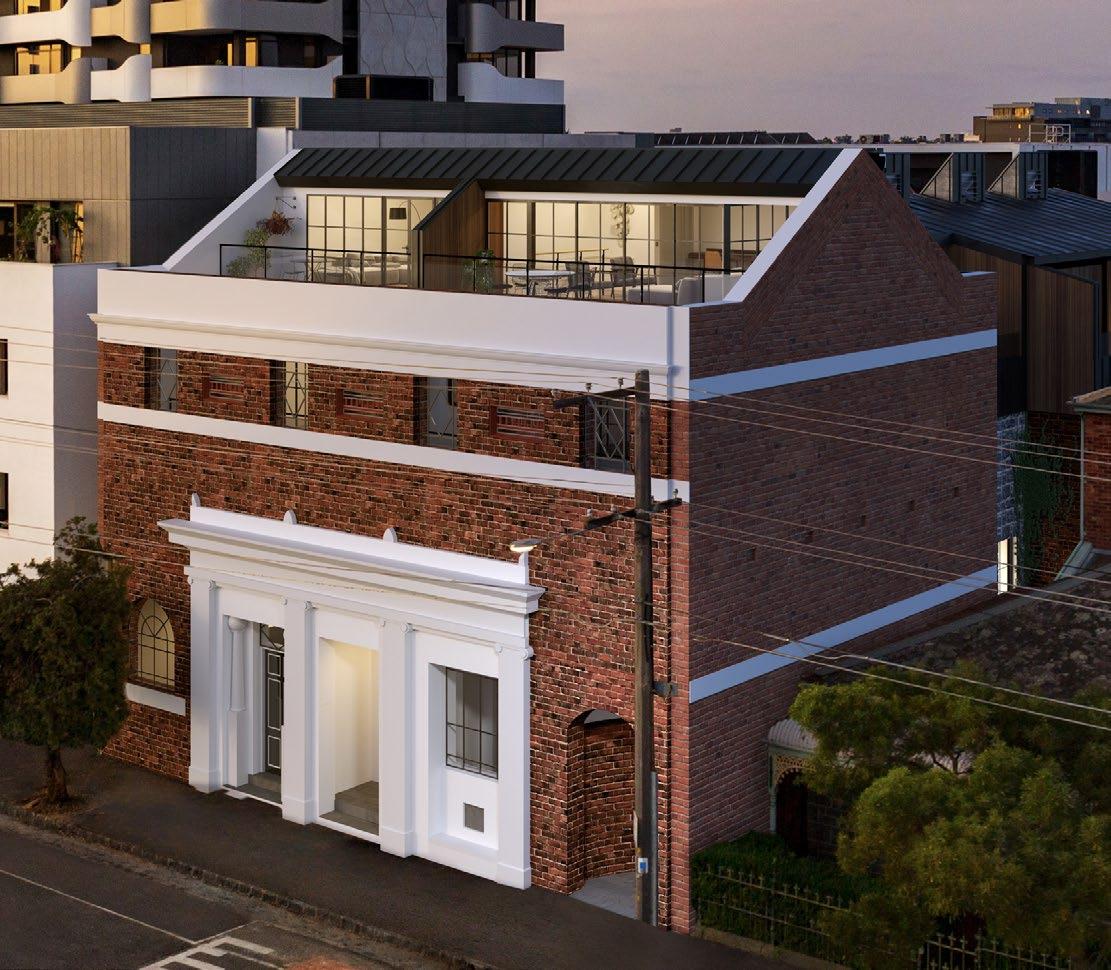
Coppin Lodge is the creative transformation of two heritage buildings into nine exclusive town residences. Quality finishes, traditional features and handcrafted elements strike the perfect balance between modern amenity and design.
No two residences are the same. Flexible floor plans mean each home is as versatile as you are. Open plan living and dining areas are perfect for entertaining. Steel-framed French doors lead to private balconies and courtyards, creating a seamless flow between inside and out.
Located in the dynamic suburb of Brunswick East, Coppin Lodge is only five kilometres north of the CBD. It is close to parklands as well as Melbourne’s world renowned universities and hospital precinct.

www.coppinlodge.com.au


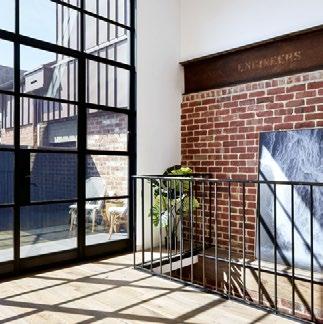

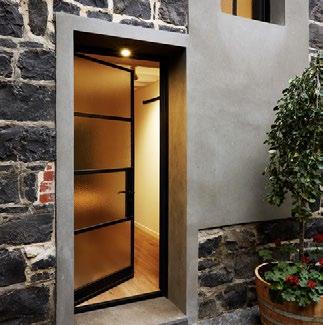

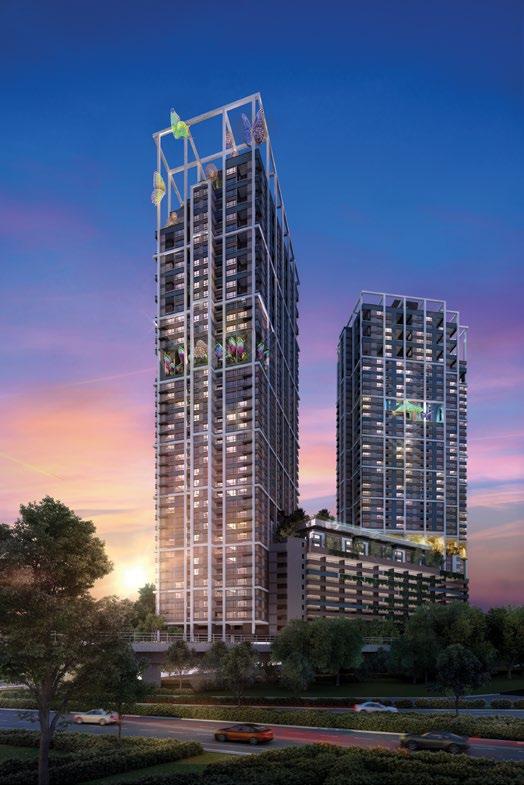

Est8 is a distinctive residential enclave within walking distance of many of Kuala Lumpur’s most sought-after shopping, transport, and entertainment destinations.
Located a few hundred metres from Mid Valley megamall and The Gardens Mall, Est8 is close to major road links and connected by a covered walkway to the LRT and KTM.
Est8 features over 40 distinctive facilities designed around the Valley of Dreams concept, the iconic masterplan behind the development’s lifestyle offering. Premium facilities include the Kaleidoscope Kitchen, a celebrity kitchen to entertain and dine with friends and family, The Secret Burrows and Grand Burrow, a state-of-the-art business centre and multipurpose hall. It also has The Wonderglades, a serene area featuring a 50-metre lap pool; fountain; allpurpose gym; play areas; and winding paths.
Est8 is naturally cooled with true cross ventilation, while the masterplan includes extensive green spaces which greatly exceed planning requirements. A safe and secure haven, Est8 features an array of private spaces, hidden gardens, and secluded walks connecting you to nature, yourself, and community.
At the heart of Est8’s design concept are many eye-catching, inspiring public art works and innovative sculptures. Combining urban art and green community, the distinctive gardens at Est8 (Floating Garden, Cloud Maze, Flutter Meadow, Paradise Blue, and Garden of Giants) are as visually pleasing as they are functional, designed by landscaping experts to elevate wellbeing and stimulate the imagination for all ages and lifestyles.

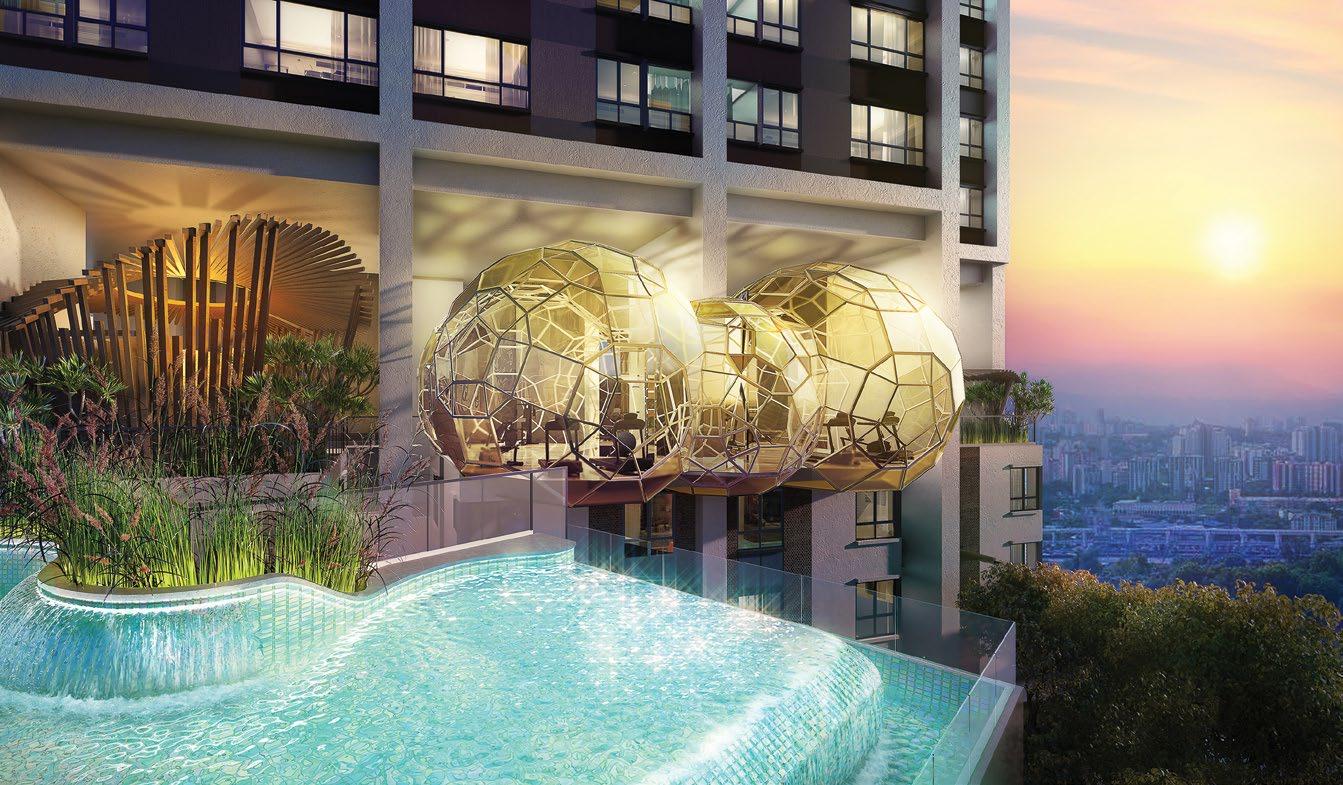





Developer: Eupe Corporation Berhad
Product type: Serviced apartment
Architect: Arkitek MAA Sdn Bhd
Launch date: November 2021
Completion date: May 2026
Total land area: 2.9 acres
Number of units: 821
Average unit size: 543–1,947 sq ft
Facilities: Facilities: Kaleidoscope Kitchen, Kaleidoscope Courtyard, 5 unique Sky Gardens, forest trails, business centre, multipurpose hall, outdoor fitness area, gym, changing room, pools, kids’ fountain, outdoor showers, whirlpool, sundeck, waterfall, and more
Monthly maintenance fees: MYR0.44
(inclusive of sinking fund)
Average price range: MYR850 per sq ft
Contact:
Phone number: +6017-275 7188
Email: marketingkl@eupe.com.my
Address: Est8 Sales Gallery, No. 21, Jalan Pantai Baharu, Bangsar South, 59100 Kuala Lumpur, Wilayah Persekutuan Kuala Lumpur, Malaysia
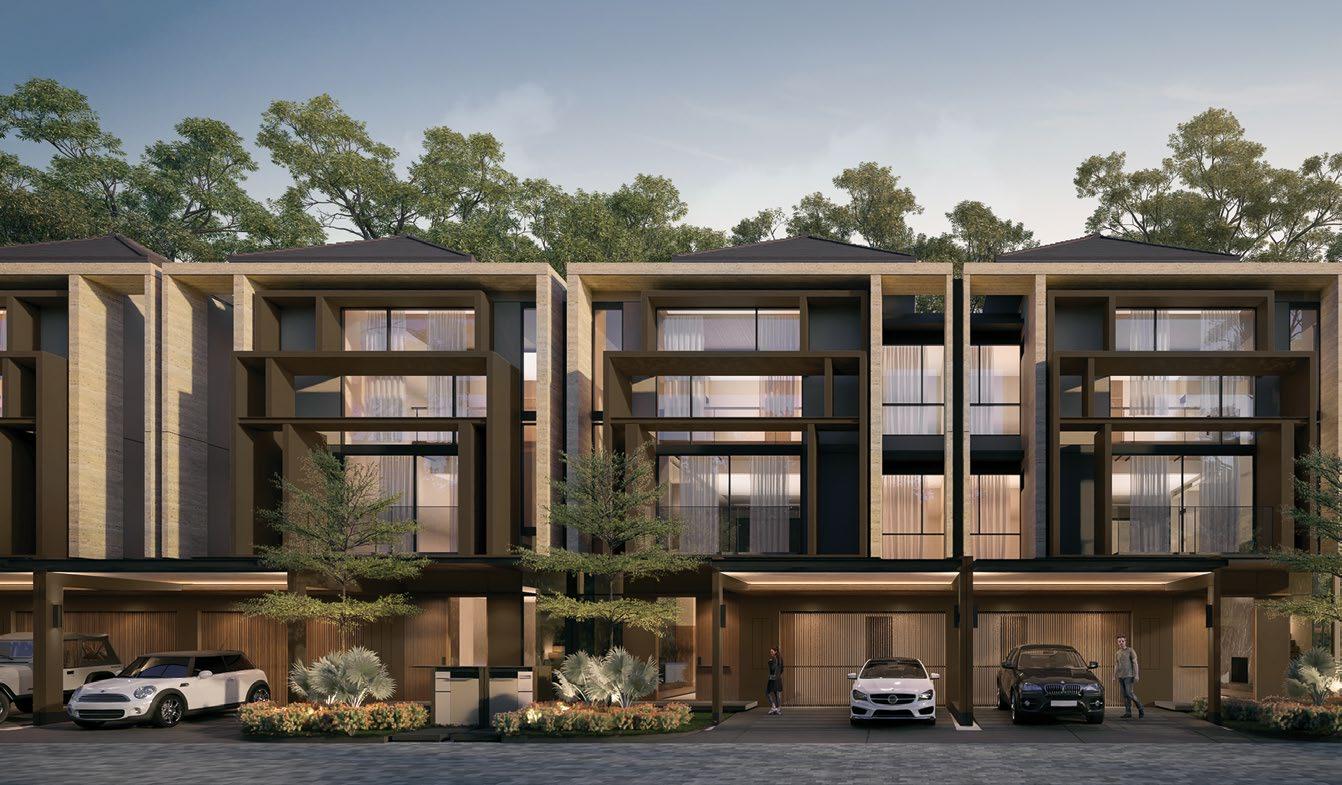
Project The Zora is a planned residential enclave in one of Indonesia’s most dynamic urban centres. Situated within the thriving economic hub of BSD City in Tangerang, Project The Zora enjoys a prime location and offers a balance of tranquillity and convenience, with easy access to essential amenities, transportation networks, and recreational facilities.
Project The Zora comprises meticulously designed homes that blend contemporary elegance with sustainable features. Residents can enjoy a harmonious living environment that promotes wellbeing and comfort. The project also presents lucrative investment opportunities, thanks to its strategic location with continuous growth potential.
At the heart of Project The Zora lies a plethora of world-class facilities, from lush green spaces and recreational areas to state-of-the-art fitness centres and community hubs. Sustainable design principles are incorporated throughout
the development, including low-E glass, solar-powered heating systems, and waste segregation facilities, ensuring a greener, more environmentally friendly community.
Showcasing Indonesian and Japanese values, the development embraces cultural diversity and harmony. The project contains thoughtfully curated public spaces such as the NAMI, OHANA, HOSHI, and HANABI Gardens, providing residents with recreational and leisure options on their doorstep. In addition, the exclusive Samasana Club House offer access to premium amenities such as an onsen pool, tennis court, and Japanese-inspired relaxation areas.
Project The Zora benefits from its proximity to a wealth of amenities, from shopping centres and schools to healthcare facilities and transportation hubs. Additionally, the development is strategically located near major highways and future transportation projects, providing seamless connectivity to Jakarta and beyond.





Developer: PT. BSD Diamond Development
Product type: Mixed Use (Landed house, shophouses, and commercial lots)
Architect: Nataneka Asimetris (landed house), Metaphor Indonesia (interior designer)
Launch date: 2017
Completion date: 2025
Total land area: 19 ha
Number of units: 432
Average unit size: 120-240 sqm
Price range: IDR 7.5-14.4 billion (USD500,000960,000)
Monthly maintenance fees: IDR1.2-2.5 million (USD80-165)
Facilities: Clubhouse (onsen pool, sauna, gym area, semi outdoor pool, tennis court, skate park, etc), kids playground, jogging track, and community area
Contact:
Phone number: 021 50 368 368
Address: My Republic Plaza (GOP 6), Jl. Grand Boulevard, BSD Green Office Park, fl. 2B unit 11B – 12, Cisauk, Tangerang 15345, Indonesia Website: www.thezora.com

The Arles is a condominium development at Fo Tan in Sha Tin, a dynamic neighbourhood also known as Hong Kong’s first new town. Set along Au Pui Wan Street, The Arles is conveniently located close to Fo Tan station at the centre of the East Rail Line of the MTR.
For residents, travelling between Admiralty, the financial centre of Hong Kong, and Shenzhen, the centre of science and technology in Mainland China, is a journey that takes just around 30 minutes.
The Arles is adjacent to the Hong Kong Science and Technology Park, the base of innovation and technology in the city. Home to more than 1,700 technology companies, the park draws numerous scientific researchers and professionals.
Only one railway station away from the Chinese University of Hong Kong, The Arles is an appealing address for academic staff
and overseas students. In addition, the East Rail Line runs through top institutions such as City University of Hong Kong, Hong Kong Baptist University, and Hong Kong Polytechnic University.
Sha Tin New Town Plaza is just across the railway station from Sha Tin Station, putting shopping, leisure, and entertainment within easy reach of residents. The Arles itself has its own podium with shopping arcade, letting residents enjoy conveniences just outside their doorsteps.
Residents can go jogging or cycling along nearby Shing Mun River and take hiking trails like Tai Mo Shan, Lion Rock, and Ma On Shan. Other nearby attractions include Heritage Museum and Tsang House.
Residents can also enjoy the approximately 120,000-sq-ft clubhouse, Club Arles, including indoor and outdoor pools.








Developer: Centralcon Properties Company Limited
Product type: Condominium
Architect: DLN Architects Limited
Launch date: September 2021
Completion date: June 2023
Total land area: 165,096 sq ft
Number of units: 1,335
Average unit size: 228-2,001 sq ft
Facilities: Outdoor pool, indoor pool, jacuzzi, indoor basketball court, 24-hr gym, banquet room, party room, café, playground, children’s indoor play room, yoga room, lawn, jogging path, BBQ area, pet area, and more
Monthly maintenance fees: HKD4.85 per sq ft
Price range: HKD3.9-48.16 million (HKD14,263-32,000 per sq ft)
Contact:
Phone number: +852 2788 0333
Email: enquiry@centralcon.hk
Address: 1 Au Pui Wan Street, Fo Tan, Sha Tin, Hong Kong

The Fullerton Ocean Park Hotel is a sustainable, familyfriendly oceanfront luxury resort that offers a relaxing, tranquil retreat in Hong Kong. This 425-room hotel is the first WELL™-accredited hotel in Hong Kong and Mainland China and has attained Final Gold rating under the BEAM Plus New Buildings Assessment.
Situated along Ocean Drive by the Ocean Park Water World in Aberdeen, The Fullerton Ocean Park Hotel commands mesmerising views of the South China Sea. The resort has many sustainability features, including a rainwater recycling system for irrigation; a high-energy-efficiency, variable-speed, tri-rotor screw chiller in the centralised air-conditioning system; a water-to-water heat pump that utilises waste heat for the hot water system; and the ORCA system for decomposing kitchen waste onsite.
The hotel supports CORAL REEFStoration, Hong Kong’s first cross-sectorial coral conservation project.
Other notable features are kids’ facilities designed for “learning through playing”, enabling them to know more about Hong Kong’s natural wonders and key attractions. These facilities include a 6,400-sq-ft indoor kids’ zone and a kids’ lagoon.
The resort is next to a 19,000-sq-ft waterfront promenade for the community’s enjoyment, too, as well as 80,000 sq ft of outdoor recreational spaces with a lounging area. In addition, the resort contains a wellness centre encompassing a 24-hour gym and luxury spa.
The hotel offers four distinctive dining concepts, showcasing fine culinary craftsmanship and palatable concoctions. Meanwhile, the expansive infinity pool offers panoramic sea views, providing the perfect setting for fitness activities and relaxation. The project also features Farm by the Ocean, an in-situ hotel farm.
The dedicated F.U.N. Desk team can curate unique experiences for guests.






Developer: Parkland (Hong Kong) Limited
Product type: Hotel
Architect: Aedas Limited
Launch date: July 2022
Completion date: June 2022
Gross floor area: 40,570 sqm
Number of rooms: 425
Facilities: Dining concepts, infinity pool, 24-hour gym, luxury spa, kids’ lagoon, indoor kids’ zone, in-situ hotel farm, and more

Le Pont Residences is the first premium high-rise residential project by RLC Residences, a subsidiary of award-winning real estate developer Robinsons Land.
The two-tower development is within Bridgetowne Destination Estate, a fast-growing township with major PEZA-accredited offices and retail establishments. As an important component of this township, Le Pont Residences benefits from its strategic location between Quezon City and Pasig, with direct access to Amang Rodriguez Avenue, C5 Road, and Ortigas Avenue.
Le Pont Residences is also the only EDGE-certified residential property within the estate, thanks to its water and energyefficiency features. This includes a rainwater harvesting facility, water-saving fixtures, ample green landscaped areas, and well-insulated roof and walls incorporated within the development.
The generously spaced, flexible units vary from 45 sqm one-bedroom to 390 sqm for the bi-level penthouses on the uppermost floors. The penthouse units feature full-length
glass windows and opulent curved staircases while all units feature a loggia or glass-railed balcony, extending living spaces further.
Le Pont Residences houses hyper-sized amenities distinct from communal areas found in conventional condominium buildings. From the podium to the mid-level and top floors, residents can enjoy a wide array of indoor and outdoor facilities. An infinity pool on the podium level which serves as a spectacular vantage point over the estate.
Le Pont Residences promotes health and fitness with stateof-the-art gyms, a yoga room, and lap pools. Residents can bond with friends and family in the private theatre, private function rooms, game room, sky lounge, and pet park.
Smart home features are integrated into the units for maximised convenience. Meanwhile, the myRLC Home portal will soon let homeowners manage units from their mobile devices while online concierge Ring Rob will deliver laundry, housekeeping, and other services at the tap of a button.
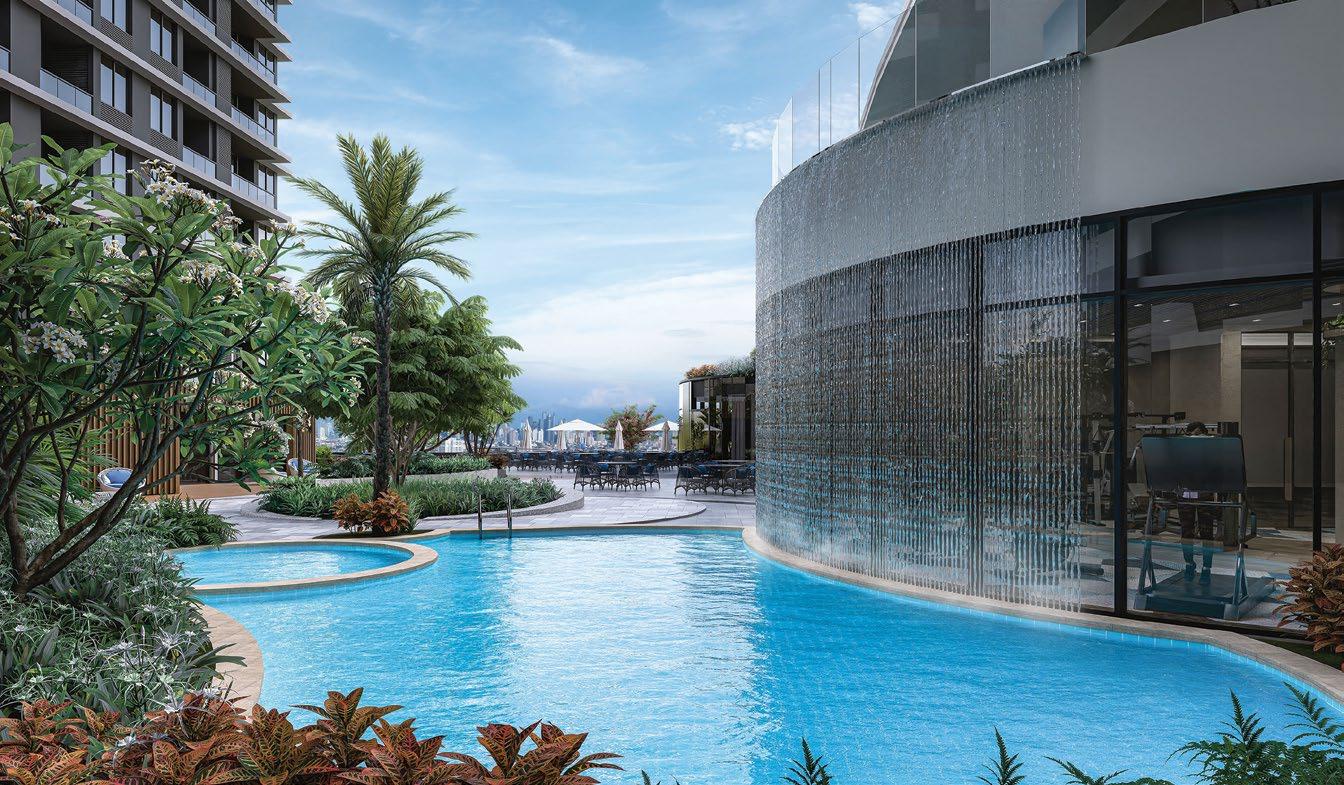



Developer: RLC Residences
Product type: High-rise condominium
Architect: Handel Architects, W.V. Coscolluela & Associates
Launch date: January 2023
Completion date: September 2028
Total land area: 7,220 sqm
Number of units: 506
Average unit size: 46-380 sqm
Facilities: Infinity pool, jogging path, pet park, work lounge, game room, private theatre, play areas, fitness gym, yoga room, private function room, sky lounge, landscaped areas, and outdoor lounge
Price range: PHP14.3-126.9 million
Contact:
Phone number: +639178625683
Email: Louella.untalan@rlcresidences.com.ph
Address: Bridgetowne East, Pasig City Philippines

A symbol of progress, Cyber Omega seamlessly integrates functionality, sustainability, and efficiency in one office development in the heart of Ortigas, one of Metro Manila’s central business districts.
Conveniently located along Pearl Drive in Ortigas Centre, this innovative development is designed to promote sustainable transportation, reduce carbon emissions, and foster a greener commute with easy access for both private and public vehicles.
Cyber Omega looks out to a panoramic 360-degree view of Ortigas, which provides a stunning backdrop for its workspaces. The building incorporates high-quality precast panels, strip and punch windows, and accented vertical panels that not only enhance its aesthetic appeal but also contribute to its energy efficiency.
Flexible, column-free tenant spaces allow the workspaces to be operationally
efficient and adaptable to businesses of all sizes. These spaces are also designed to accommodate the needs of Persons with Disabilities (PWD), reflecting an inclusive approach to modern office design.
Cyber Omega offers ample end-of-trip facilities like bicycle racks and shower provisions, encouraging workers to embrace a greener lifestyle and cultivating a culture of sustainability in the office.
A dynamic social hub at Cyber Omega, complemented by a vast selection of retail options within the vicinity, lets tenants collaborate, connect, and create, achieving work-life balance.
Cyber Omega has attained EDGE Certification with 24% energy savings, 55% water savings, and 50% less embodied energy in materials, setting a new, green standard for office buildings in the Philippines.




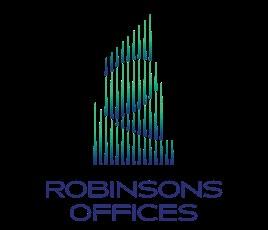
Developer: Robinsons Offices
Product type: Office building
Architect: JSLA Architects
Launch date: March 2021
Completion date: March 2021
Total land area: 3,148 sqm
Facilities: N+1 Redundancy, VRF Airconditioning System, 13 elevators
Contact: Phone number: 09189418651
Email: offices@robinsonsland.com
Address: Cyberscape Alpha, Sapphire and Garnet Roads, Ortigas Centre, Pasig City, Philippines
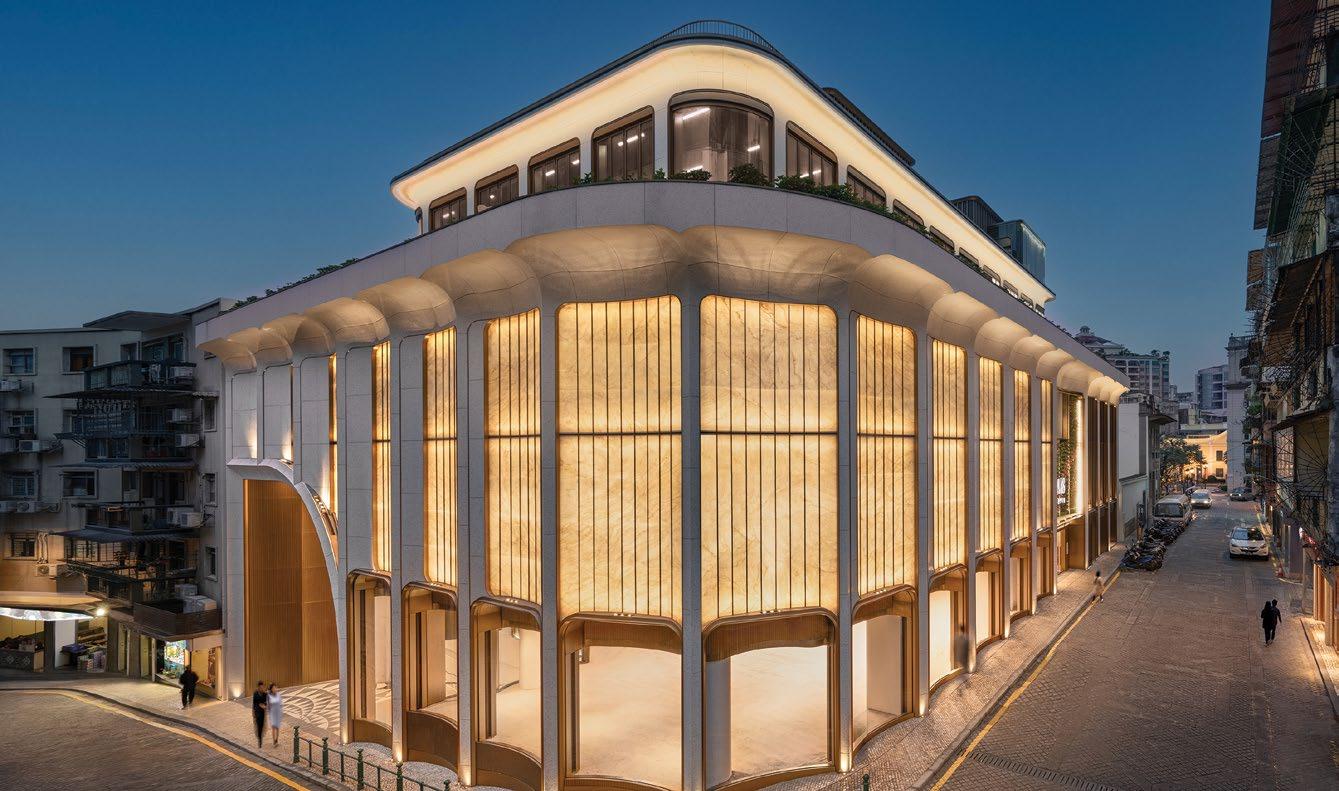
M8 is a cultural retail destination that draws inspiration from Macau’s rich heritage. Located in Macau’s UNESCO district, the project pays homage to the city’s historic context by linking vibrant Senado Square with the surrounding old streets.
Set at the intersection of Travessa do Roquete and Rua da Sé, M8 is within a 10-minute walk from Senado Square and the General Post Office. Senado Square, a UNESCO World Heritage site, features traditional Portuguese calcada paving stones. The General Post Office, a beautiful blend of European and Chinese architectural elements, now houses the Communications Museum. Nearby, The Ruins of St. Paul’s, another UNESCO World Heritage site, stands as an icon of Macau’s multicultural history.
M8’s design embraces a sense of locality by blending Chinese and Western elements; integrating modernity with tradition and
history; combining dynamic and static aspects; and reinventing the past. The building “grows” naturally from the land, following the cultural context, and integrates with neighbouring historic buildings, communities, and urban areas.
The construction of M8 focuses on quality craftsmanship and the creation of a sense of place. The sculptural glass façade incorporates 1-millimetre-thick, translucent stone laminates, resulting in a captivating interplay of light in the evening.
Notably, M8 holds the Guinness World Record for “the largest curved stone-laminated glass façade” in the world.
M8 is developed by China State Construction Engineering (Macau) Co., Ltd., an affiliate of China Overseas Group. Established in 1981, the company is one of the largest contractors and most diversified investors in Macau.







Developer: China State Construction Engineering (Macau) Co., Ltd.
Product: A new landmark at the heart of Macau World Heritage area
Architect: The Oval Partnership
Total land area: 948 sqm


JARDINI is a new, rare condominium development by CITIC Pacific Ltd in a traditionally luxurious residential area at Jardine’s Lookout in Hong Kong.
Located at 135 Tai Hang Road, Hong Kong, the project boasts a unique geographical advantage. This “golden” site faces Victoria Harbour and the Kowloon Peninsula, with the greenery of Jardine’s Lookout as its backdrop. The project features worldclass, innovative architecture, creating a unique landmark in Jardine’s Lookout and giving residents an elegant, premium living environment.
JARDINI’s architectural design takes inspiration from the sky. Its curvilinear silhouette flows gracefully like undulating clouds, blending elegance and harmony while giving the buildings a unique character. The wavy, streamlined design of the towers creates a visually appealing façade that reflects the project’s dynamism and charm. Clad in a shimmering aluminium
finish, the façade and balconies give the towers a lovely glow under different lighting conditions.
The clubhouse and sky garden of JARDINI were designed to consider the holistic needs of residents and create a healthy, comfortable environment. Various species of evergreen plants were introduced into JARDINI, enhancing the outdoor areas of the development. The plants were carefully selected to create a diverse, vibrant natural environment.
The landscaping design cleverly covers outdoor spaces with ferns and shrubs, resulting in a harmonious integration of different plant species. Multi-angle lighting art installations are strategically placed throughout the outdoor spaces to highlight the site’s natural beauty and create a captivating atmosphere.









Developer: : CITIC Pacific Limited
Product type: Condominium
Architect: Wong Tung & Partners
Limited
Launch date: May 2024
Completion date: March 2026
Total land area: 42,950 sq ft
Number of units: 114
Facilities: Sky garden, swimming pool, multi-function room, banquet room, yoga room, gym room, BBQ patio, children’s play area

The LakeGarden Residences is a condominium development by Wing Tai Asia at 80 and 82 Yuan Ching Road in Singapore. A testament to the future of sustainable living, it harmoniously combines tranquil lakeside living with a deep commitment to environmental stewardship.
Comprising 306 units across two 19-storey towers, The LakeGarden Residences offers an impressive range of residential options. From chic one-bedroom apartments to expansive five-bedroom residences and four extraordinary penthouses, this development caters to diverse lifestyle needs while delivering unparalleled vistas of nature.
The LakeGarden Residences has achieved Green Mark Platinum Super Low Energy status, underscoring the development’s dedication to sustainability and energy efficiency. The buildings have a remarkable 60% crossventilation rate, promoting a healthier indoor environment and naturally reducing median temperatures, thereby minimising reliance on air-conditioning.
Every unit at The LakeGarden Residences is fitted with bestin-class, energy-efficient, high-performance appliances, reducing overall energy consumption while aligning with a luxurious yet responsible lifestyle.
The LakeGarden Residences boasts four dedicated electric vehicle (EV) charging lots and 50 additional EV-ready lots. This infrastructure prepares residents for a future that prioritises eco-friendly transport options that have no need for carbon-emitting fuels.
Seamlessly integrated with nature, the towers offer panoramic views of the Jurong Lake Gardens. This connection with nature provides a serene and sustainable living environment amidst the urban setting.
Property seekers seeking tranquillity, luxury, and sustainability will find The LakeGarden Residences ideal with its thoughtful design, eco-conscious features, and stunning vistas. Here, residents can enjoy a luxurious lifestyle that does not compromise environmental responsibility.








Developer: Wing Tai Asia
Product type: Condominium
Architect: Surbana Jurong Architects
Launch date: April 2023
Completion date: August 2027
Total land area: 12,465 sqm
Number of units: 306
Average unit size: 970 sq ft
Facilities: 50m stardust pool, kids’ pool, kids’
playground, clubhouse, gym, tennis court, glamping pavilion, BBQ Zone, yoga lawn, jacuzzi lounge, and more
Carpark: 306 lots (4 EV & 50 EV-ready lots)
Monthly maintenance fees: SGD400-560
Price range: SGD1.2-3.5 million
Contact:
Tel: 6380 3800
Email: enquiry@thelakegardenresidences.sg
Address: 80 & 82 Yuan Ching Road, Singapore


PROPERTY REPORT MAGAZINE FOUNDER TERRY BLACKBURN AND PUBLISHER JULES KAY AT A MEDIA EVENT TO COMMEMORATE THE INDUSTRY-LEADING PUBLICATION’S EXPANSION AND 10TH ANNIVERSARY IN 2014
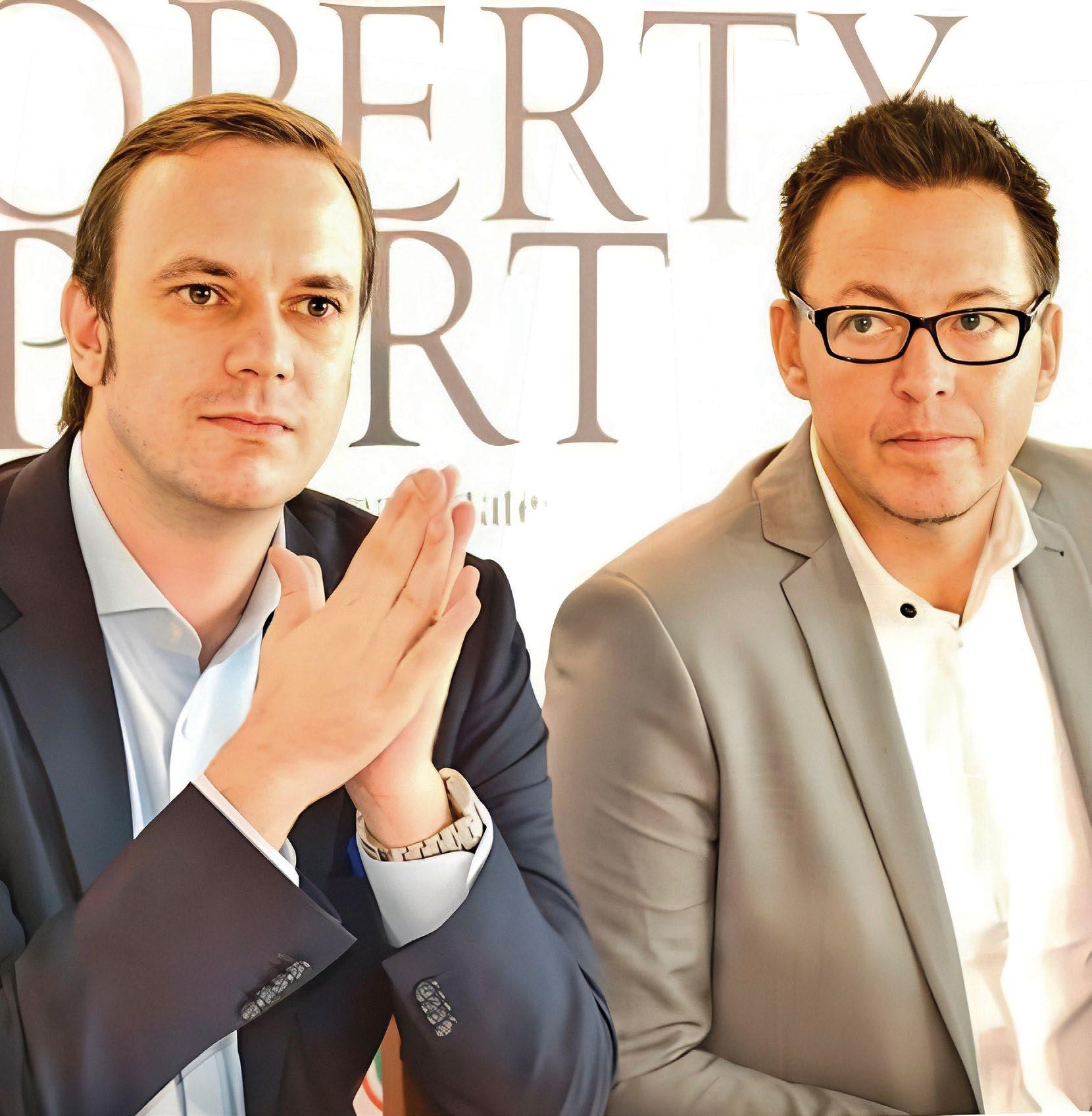

Crafted for those who demand the best.
Embracing a century-long legacy of Swiss excellence, V-ZUG has reshaped household living with its distinguished range of premium appliances, spanning from ovens and dishwashers to refrigerators, washers, dryers, and beyond. Integrating pioneering steam technology and prioritising sustainable, carbon-neutral production, V-ZUG is renowned for meticulous craftsmanship and enduring refinement, offering an unmatched expression of Swiss luxury and innovation in every home.



